Winding Roads

Fords Triumphant
How Ron Jenkins ’76 found a calling in prison Creative Sparks A truly inspirational artistic collaboration

Winding Roads

Fords Triumphant
How Ron Jenkins ’76 found a calling in prison Creative Sparks A truly inspirational artistic collaboration
How one alum’s journey with Parkinson’s disease is reshaping research in Haverford’s blossoming neuroscience program PLUS: SCENES FROM COMMENCEMENT AND ALUMNI WEEKEND

Editorial Director
Dominic Mercier
Editor
Brian Howard
Class News Editor
Mara Miller Johnson ’10
Copy Editor
Colleen Heavens
Photographic Director
Patrick Montero
Graphic Design
Anne Bigler
Vice President for Marketing and Communications
Melissa Shaffmaster
Associate Vice President for College Communications
Chris Mills ’82
Vice President for Institutional Advancement
Kim Spang
Contributing Writers
Charles Curtis ’04
Debbie Goldberg
Ron Jenkins ’76
Curran McCauley
Hillary O’Connor
Patrick Rapa
David Silverberg
Anne Stein
Contributing Photographers
Holden Blanco ’17
Dan Z. Johnson
Paola Nogueras
Mac Sanders ’24
Haverford magazine is published three times a year by Marketing and Communications, Haverford College, 379 Lancaster Avenue, Haverford, PA 19041, 610-896-1000, hc-editor@ haverford.edu
©2025 Haverford College
Advancement Services
Haverford College 370 Lancaster Avenue Haverford, PA 19041 or devrec@haverford.edu

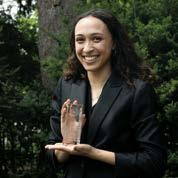
30 Tell Us More
Leighton Rice ’06: The Apples of His Eye
By Hillary O’Connor
32 Building a New Brain Trust
How one alum’s journey with Parkinson’s disease is fueling ethical inquiry in Haverford’s blossoming neuroscience program. By Dominic Mercier
Plus: Navigating Uncertain Terrain
What changes in the federal funding landscape mean for STEM research at Haverford. By Chris Mills ’82
40 The Art of Collaboration
This fall, thanks to a grant from the Pew Center for Arts & Heritage, a thriving Haverford partnership will put neurodivergent artists in the national spotlight. By Anne Stein
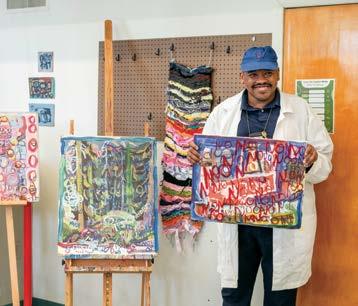



Come to Haverford, and you’ll find yourself surrounded by curious, smart people who are dedicated to and love learning. You’ll also find a shared interest in making Haverford, and the world, a better place.
The pursuit of such worthy goals inevitably brings disagreement or even conflict. The past few years have been particularly fraught for those of us in higher education. Even when we have shared values, the journey of discovery brings the potential for disagreement at every step.
But as I see it, the fact of disagreement isn’t the problem; the question is, what do we do with it? You could say that at Haverford, disagreement is a feature, not a bug—all toward improving how we offer an incomparable liberal arts education in a living, learning, teaching, and working community.
Disagreement is often uncomfortable, particularly before it reaches a productive outcome that dialogue across difference ideally yields. Unfortunately, I see our society growing less accustomed to sitting with and engaging ourselves in this kind of discomfort, partly because we live at a time when vehement disagreement, lack of engagement across those disagreements, and a relative paucity of constructive outcomes are often rewarded. Waging our disagreements via social media, while theoretically an open venue for engaging in queries, listening, and conversation, often inflames rather than settles.
All this can make it difficult to disagree with people, let alone use disagreement as a productive and constructive way forward. And move forward we must.
In uncertain times, I have found that one’s foundational principles provide a dependable resource for navigating necessary change, particularly when that change is accompanied by the friction of disagreement.
Such guidance by principle, for me, is tap-rooted in my work as a molecular biologist. Natural laws create the foundation for how atoms and molecules interact to build and regulate cells. Relying on well-known physical principles governed my laboratory experiments, even as I used those experiments to discover previously unknown ways that cells work. But this process of discovery necessarily gave rise to disagreements about approach, interpretation, and conclusion. My fellow researchers and I never could have worked our way through those without first accepting—no, embracing—the very existence of differences among us as the work progressed. Such a mindset inclined us all toward learning, discovery, helping one another to be better scientists, and promoting constant progress.
Here at Haverford, we are fortunate to be able to rely on the longstanding strength of our mission and values, particularly at times like the present, when pressures across higher education demand a good deal of smart navigation and resourceful
planning. Such values inform distinctly Haverfordian principles that are key to our success, and chief among them is the principle of respect for and expectation of each member’s contributions to this community. We saw the fruits of collaboration in the creation of Better Learning, Broader Impact: Haverford 2030, whose recent outcomes include a new curricular program in entrepreneurship, the curricular and programmatic launch of the Michael B. Kim Institute for Ethical Inquiry and Leadership, expansion of paid summer research experiences once during every student’s four years, and implementing a campus-wide compensation study to ensure the market competitiveness of faculty and staff salaries.
Shared principles enable the work of community while also shaping queries— of ourselves, and others—that can help us move through and beyond disagreement. (Make no mistake, each of these examples saw plenty of disagreement during the shaping of the final form.)
Additionally, four collaborative community endeavors are both testing and showcasing the power of foundational principles to inspire and guide the work, while providing venues for engaging across difference:
No other college or university offers a learning and living experience like Haverford, where students have unparalleled opportunities to shape their own path and collaborate in community. This spring, we developed a draft set of core values that define the type of campus culture that we collectively aspire to uphold.
“
In uncertain times, I have found that one’s foundational principles provide a dependable resource for navigating necessary change.
”I don’t need to tell you how and why our student-administered Honor Code is central to the Haverford experience. And, as is the case with all our institutional policies, the Honor Code exists within, and must comply with, federal and state legal frameworks. In order to address some misalignments between the Code and the current legal landscape, a revised Honor Code, drafted in consultation with the Honor Council cochairs and Students’ Council co-presidents, is temporarily in effect. A working group of students is spending the summer drafting a Code for consideration at a Special Plenary this fall in order to address these misalignments while maintaining the integrity, purpose, and spirit of the Code.

After several months of extensive engagement with on- and off-campus community members, and informed by expert literature and best practices in higher education, the Ad Hoc Committee on Freedom of Expression, Learning, and Community has issued its final report. The report details areas of concern, strength, and opportunity that sit at the intersection of expressive freedom and fostering a campus community in which all members can thrive. I thank the committee for its indepth and thoughtful work and will lead the implementation of many of the recommendations contained within the report in order to advance Haverford’s educational mission, now and well into the future.
We have developed an interim revision to the Policy on Expressive Freedom and Responsibility to better articulate the College’s commitments and each community member’s rights and responsibilities. We are in the process of reviewing feedback and will discuss with campus stakeholders and finalize changes to the interim policy this fall.
Ambitious, worthy, essential undertakings all, each has the potential to unite and empower individuals and our community. As you might expect, the efforts that have brought each working group to the point of deliverables has relied on our core principles to define and spotlight goals, while also giving those in the groups—and you, via our feedback process—a basis for crafting argument in favor or against specifics along the way. The experience reminds me of my work back in the labs of Cornell and Harvard, where I learned to acknowledge, then embrace, then work with difference, all in service of a stronger outcome.
And, like the healthy and productive disagreement that has marked these recent engagements, I fully expect that many of us—you, me, the greater Haverford community on campus and beyond—will find discernment through dialogue that, even with disagreement, advances our beloved Haverford.
I will welcome that dialogue.
With gratitude,

I very much enjoyed Eils Lotozo’s article in the latest Haverford magazine about alums in historic preservation (“Building on the Past,” Winter 2025), but was a little startled to see that none of those profiled were architects. Can it be that I am the only one?
While I love preservation advocacy and have served on my share of design review boards over the years, I have to point out the difference between advocacy and action. It takes a dedicated team of architects, engineers, and contractors, as well as advocates, to move a project from concept to reality.
After graduating in 1973, I spent three years teaching in a Friends elementary school while figuring out what I might want to do with the rest of my life. I came to believe that architecture offered a path to indulge many of my interests in a career where I could even make a living. The Haverford career center was

Ask a question or offer a comment on one of our stories. Tell us about what you like in the magazine, or what you take issue with. If your letter is selected for publication, we’ll send you a spiffy Haverford College coffee mug.
Email: hc-editor@haverford.edu Or send letters to: Haverford magazine
Marketing & Communications
Haverford College
370 Lancaster Ave.
Haverford, PA 19041


able to connect me with alumni who had followed such a path, and I soon moved to Salt Lake City to obtain a master’s in architecture.
I retired in 2020 after a career in which I worked on hundreds of existing buildings and exactly two new buildings. One of the pleasurable side effects of working on historic buildings is that they have already established their place in local culture and society, and their restoration, preservation, or adaptive reuse is a statement of their value. Very few of the buildings that I have touched over the years have been demolished.
What I learned along the way was that my Haverford education was much more important than my architectural degree, something I never fail to tell prospective students. So much of architecture has changed in the last 50 years, but the process has always involved the same skills of problem identification, analysis, communication, and consensus that I first learned at Haverford.
Architecture is a communal art form, and historic buildings are a community resource. All of those that you profiled in your article are participating in a continuing collaboration that eases the transition of communities from the past to the future. They all play different but
essential roles in this collaboration. But don’t forget the architects!
—Jim McElwain ’73
Thanks for Eils Lotozo’s excellent article “Building on the Past.” I am Aaron Wunsch’s father. I think of him every moment, it seems. I know he would have taken great pleasure from your article and your treatment of him and his students. —A. David Wunsch
I was particularly excited to see that you mentioned my “grandplant’s” application to Haverford for the class of ’26 in Jill Waldbieser’s story “A Growing Tradition” (Winter 2025). I would like to clear up a small misunderstanding in your article, though. Roger’s application to Haverford was never actually denied. We never received a response from [Vice President of Admission] Jess Lord, so we presumed the application was lost in the mail during COVID. I had been in contact with [Arboretum Program Coordinator] Jennie Kelly back in 2022 about Roger, so she likely misremembered the outcome of his application.
Once again, thanks so much for reviewing the topic, and I’ll be sure to let Roger know that he made it into the magazine again.
—David Schutzman ’74, P’06

Commencement was a picture-perfect sendoff for the 394 members of the Class of 2025. FOR
At Commencement, 394 Fords crossed the stage and into the next chapter of their lives. BY
DOMINIC MERCIER
On Saturday, May 17, families, friends, faculty, and staff gathered in Alumni Field House to celebrate Commencement with Haverford’s Class of 2025. Under skies that shifted from overcast to dazzling, the College honored the accomplishments and resilient spirit of 394 Fords who began their journey amid a global pandemic and emerged from their academic experiences transformed.
The weekend’s festivities were not limited to Saturday. In the days leading to Commencement, the College honored the identities that shaped the Class of 2025 with


celebrations for Chesick Scholars, international students and their families, students of color, and the College’s LGBTQIA+ community. The cheerful—and sometimes emotional—gatherings reflected the many ways the class supported one another with care and intention.
In delivering his remarks for the Class of 2025, Yehyun Song ’25 proudly declared his peers “The Class of Doers.” Recounting their journey from COVID-era uncertainty to embracing their roles as tomorrow’s leaders, Song praised classmates who reinvigorated Haverford’s campus life post-pandemic, creating new opportunities and
filling the campus with “life, laughter, and love.”
“If there’s one thing the Class of 2025 knows how to do, it is to live and lead in uncertainty. In fact, we’ve spent the last four years doing exactly that,” he said. “We didn’t wait for a perfect moment to get involved. We did what we could, where we were, with what we had.”
Student-selected speaker and Laurie Ann Levin Professor of Comparative Literature Maud McInerney drew on poetry to mark the moment, turning to the works of Audre Lorde and Adrienne Rich to illustrate how language and imagination could illuminate the graduates’ path forward.
“Poetry is not a luxury,” McInerney said, quoting Lorde. “It is a vital necessity of our existence. It forms the quality of the light within which we predicate our hopes and dreams toward survival and change, first made into language, then into idea, then into more tangible action.” She urged grads to stay attuned to beauty, justice, and truth: “Keep reading. Keep writing. Keep thinking.”
The College also continued its tradition of awarding honorary doctorates to individuals whose lives and work exemplify the College’s mission. This year, two Haverfordians were honored: Katrina Spade ’99 and legendary track and cross country coach Tom Donnelly.
Spade, the founder and CEO of Seattle-based Recompose, shared her journey from anthropology major to advocate and leader for compassionate and sustainable death care. She urged graduates to embrace uncertainty, lead with curiosity, and “fight like hell for a livable planet.” Donnelly, who retired last year after an astounding 49 seasons, offered graduates one last bit of coaching: “You’re almost at the finish line—but it’s also the starting line of the next race.”
As Dean of the College and Vice President John McKnight called their names, each graduate strode across the stage to receive their congratulatory handshake from President Wendy Raymond and revel in cheers. With tassels turned and futures unfolding, the Class of 2025 stepped into the sunlight, ready to carry their Haverford experiences into the wider world.

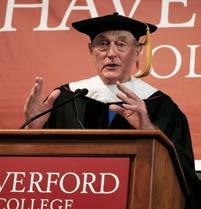

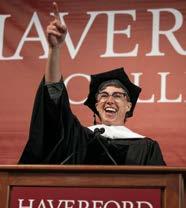

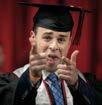


Capping it off: The Class of 2025 makes its way to Alumni Fieldhouse (1); one Ford is ready to say goodbye (2); Yehyun Song ’25 addresses “The Class of Doers” (3); legendary track coach Tom Donnelly receives his honorary doctorate (4); marking the moment, Haverford style (5); one excited Ford celebrates his accomplishments (6); a family grabs a quick selfie outside the Gardner Integrated Athletic Center (7); President Wendy Raymond congratulates a graduate (8); Katrina Spade ’96 encourages the class to “fight like hell for a livable planet” (9); three Fords make last-minute adjustments before the ceremony begins (10).
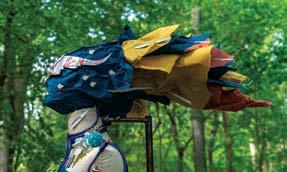
One Person’s Trash In recognition of Earth Day, Administrative Assistant Jake Gaspari curated the pop-up exhibition Rebirth along the College’s Nature Trail. The featured artworks, which included pieces created by students, faculty, neighbors from nearby Narberth, Pa., and Gaspari himself, were all made from recycled or repurposed materials. Though it was only on view for two and a half hours, the exhibition provided a delightful surprise for hikers and runners and has inspired Gaspari to consider more ways to bring art to the College’s scenic spaces.
Game On for Giving The fourth annual Gameday Fords Giving Challenge shattered records, raising nearly $440,000 from 1,209 donors—more than double the goal. Support came from alumni, parents, students, and even incoming members of the Class of 2029. All 23 varsity teams benefited, with fencing, field hockey, and cricket leading the charge. Matching gifts amplified the impact, helping to fund the scholar-athlete experience across campus.
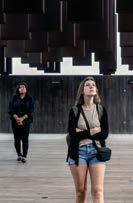
March Through History For the second year in a row, Haverford students, faculty, and staff journeyed through the American South during spring break as part of the College’s annual civil rights trip. The journey led them through many key sites of the U.S. Civil Rights Movement, from Charleston, S.C.’s slave auction sites and plantations, to the historic streets of Montgomery, Ala. The weeklong experience, organized by the College’s Institutional Diversity, Equity, and Access division, provided Haverford’s travelers with a deeper understanding of the ongoing fight for racial justice.

BIG BANG ... AND A BIG HONOR
Professor Emeritus Bruce Partridge, a pioneer in observational cosmology, was elected to the American Academy of Arts and Sciences. Known for his research on the cosmic microwave background—the heat that remained after the Big Bang created our universe —and his contributions to major international projects like the Planck satellite, Partridge has also inspired generations of students through his decades of teaching and mentorship. His election honors both his scientific achievements and his continued impact on the Haverford community.
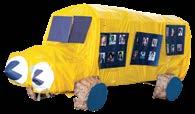
April Fools With a Scientific Twist Pranksters at Koshland Integrated Natural Sciences Center (KINSC) struck again, transforming it into a whimsical wonderland this April Fools’ Day. Students from the biology, chemistry, math, and physics and astronomy departments decked the halls with handmade decorations: a Magic School Bus, Super Mario’s Mushroom Kingdom, a “Mathopoly” board, and a Magic: The Gathering tribute featuring professors and their unique powers.
Crankie Through a performance organized by Visiting Assistant Professor of East Asian Languages and Cultures Honglan Huang, interdisciplinary artist Maisie O’Brien demonstrated for the College the art of illuminated crankie theater. The illuminated scrolling panorama is a method of storytelling rooted in ancient Indian and Indonesian traditions, where scrolls were used to tell stories drawn from religious epics. O’Brien’s performance combined shadow puppetry and song, proving that traditional techniques can play a powerful role in contemporary storytelling.

Delaney Kenney ’25, a neuroscience major with minors in psychology and museum studies, is Haverford’s first FAO Schwarz Fellow. This prestigious two-year fellowship at Boston’s Museum of Science will have her designing youth programs and in-gallery experiences to make STEM more accessible. Inspired by her own journey—which includes a diagnosis of Ehlers-Danlos syndrome and a transformative internship in Colorado—Kenney looks to turn science communication into an impactful tool.


Traditional Chinese Dance In April, the Bi-Co Chinese dance group Mei filled Marshall Auditorium for its spring showcase. With the theme “A Wordless Poem,” the performances found inspiration in Chinese poetry, murals, and music—transcending linguistic barriers to highlight the ephemeral beauty of spring. A week later, Mei cheered on five of its dancers as they traveled to Los Angeles to compete in the prestigious World Culture Dance Competition.
Conclave Confidential As the world waited for white smoke to billow from the Sistine Chapel’s chimney, Associate Professor of Religion Molly Farneth, who teaches a course on the politics of ritual, spoke with the New York Times about the importance of the papal conclave that eventually elected Pope Leo XIV. Farneth discussed the metaphor of handing the keys of the Catholic Church to a new leader and whether or not Pope Francis’ successor, through the moral authority granted to him, could shrink or expand the church’s community.
Fords were encouraged to take a moment to connect with the sounds around them when renowned New Zealand-born contemporary composer and sound artist Annea Lockwood visited campus in March. Lockwood, who burst onto the scene in 1968 with a performance that included lighting a piano on fire and recording it, led Fords through an immersive exploration of deep listening and ecological awareness as part of the Bi-Co Environmental Studies program’s Re(Growing) a Living Culture series.


Curator Rainey Tisdale ’94 has been preserving verse and storing it in jars—because nourishment comes in many forms.

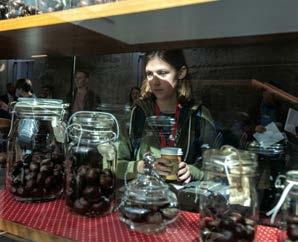
When she was a Haverford student, Rainey Tisdale ’94 found comfort and solace in the thousands of trees on campus. As her family life back in North Carolina unraveled “like a southern gothic novel,” the arboretum became her refuge, a place where she could set her roots in the face of uncertainty.
“When I visited Haverford on my college tour, I could feel how special it would be to go to school in the middle of an arboretum. I felt that viscerally,” Tisdale recalls. “It’s a big part of why this place felt so right to me.”
In April, Tisdale returned to campus to install Provisions, an exhibition in Lutnick Library that channeled her experiences into a tender offering: 81 jars of what she calls “poem preserves.” Each is filled with buckeyes, the seeds of certain Aesculus trees, that Tisdale collects after they fall. She then
dries them and inscribes each with lines of poetry in tiny, meticulous script. Each jar is marked with a tag indicating the poet and poem contained within and includes at least one buckeye Tisdale collected from Haverford’s 18 Aesculus trees. The exhibition was on view through early June.
The assemblage of jars, which Tisdale finds at thrift stores and upcycles, resembles an oldfashioned larder. That’s precisely the point, she says. “I’m drawing on the pantry as an important metaphor. We need to preserve and put by for the long winter our poems, just as much as we need to preserve our peaches, okra, and tomatoes, because poems also nourish us in a way we need to be nourished.”
Tisdale, a museum curator in her daily life, began writing poetry on buckeyes more than a decade ago. She says she found inspiration in the buckeyes’ natural form, the tactile process of
painstaking handwriting, and her family history: Her father was a prolific poet, and she grew up surrounded by his verse. The transcription process, slow and meditative, is almost a form of devotion that allows Tisdale to absorb each poem word by word, she says.
“Organized religion never took for me,” she says. “I explored a few of them, the major ones, and they just didn’t inspire me. But somewhere along the way, much later in life, I realized creativity has always been my religion and poetry is the sacred text.”
The notion for the exhibition grew from Tisdale’s long friendship and shared love of poetry with Haverford staff member and poet Charlotte Boulay. Together, they issued a call to Haverford’s community seeking original poems or suggestions for published works that community members found particularly meaningful. The collection they’ve curated includes works by established poets such as Tracy K. Smith and Elizabeth Bishop alongside contributions from alums and students. Boulay’s poem “Foxes on the Trampoline,” the source for one of the first jars Tisdale ever created, was also featured.
“The vernacular of Rainey’s artistic practice spoke to me from the beginning,” says Boulay. “I’ve lived with the jar of my poem that she made for me some years ago for a while now, after she gave it to me. My first book came out 11 years ago this spring, and this collaboration has helped my writing by convincing me that I should keep at it, and that my poems might still have something to say.”
While some of Tisdale’s jars have appeared in smaller-scale installations—most notably the Fulbright Scholar Program’s offices in Sofia, Bulgaria, last year—Provisions was her largest display so far. It arrived on campus at the perfect time, as April is National Poetry Month. During the opening reception, which Tisdale describes as “very gratifying,” community members read poems and walked away with their own buckeyes inscribed with the words: “You are poetry.”
“We’re living in a time of great uncertainty. We spend a great deal of that time at work,” says Boulay. “It means a lot to me that Rainey and I proposed a small way of speaking to each other and to the community through this exhibit that might remind people that both poetry and the natural world can be a respite, and perhaps a guide.” —DM
WHO: Tea aficionados and first-year students Esme Dorsey ’28 and Ian Trask ’28 felt that Haverford could use a recurring klatch for their tealoving peers, from novices to seasoned sippers, to explore the vast world of steeped beverages together. The result is the Tea Tasting Club, one of the College’s newest student-run organizations. Trask, who has been drinking tea since his mother began bringing back unfamiliar varieties from her global travels, says he has long dreamed of starting a tea club. Dorsey, who discovered a love of tea during the pandemic, figured the club would be a good way to meet new people and taste new flavors.
WHAT: The club meets about every two weeks during the academic year to discuss and sample the ethically sourced teas it acquires online or from Ardmore’s The Head Nut. Typically, about 20 Fords turn out to filleth their cups with brews of three different flavors, from classics like Earl Grey and Irish Breakfast to more unique offerings, like the blue-hued Indigo Punch. The club’s future plans include exploring iced varieties in warmer months and educating about the art of tea making.
WHERE: Most events are held in room 102 of the Visual Culture, Arts, and Media building thanks to its fireplace and generally cozy atmosphere. The club also uses other campus locations, like the Skate House, when available.
WHY: In addition to introducing Fords to different teas, the club seeks to foster a greater sense of community on campus. Trask’s and Dorsey’s focus extends beyond the kettle to raising awareness of tea’s colonial history and the social impacts surrounding its production. “We do our research when we buy our teas,” says Trask, “and talk about how colonialism, child labor, and bad labor practices are continuing problems in many areas where tea is grown.” —DM
Follow the club on Instagram: Haverford kcc

Taught by:
Mellon Post-Doctoral Fellow and Visiting Assistant Professor Ezgi Guner
What Guner says about her course: This advanced seminar is an anthropological exploration of empire, both as an analytical category and a historical phenomenon. In the first half of the course, we focus on the historical entanglements between the discipline of anthropology and empire. This exploration ranges from early modern travel writing to the colonial practices of collecting, classifying, and exhibiting objects as well as humans and human remains, for instance, in world’s fairs or anatomy museums.
The second half of the course examines the anthropological critiques of this legacy. Each week, we engage with ethnographies of empire from Latin America, the Caribbean, Africa, the

Middle East, and North America. Through this global examination, students deepen both their regional knowledge and conceptual understanding of race, settler colonialism, empire, museums, and restitution.
Guner on why she wanted to teach this class: This course emerged from my own research interest in the intertwined histories of empire in the Middle East and Africa and their ongoing legacies in the present.
I also have an interest in the history of the discipline, which is inseparable from the formation and consolidation of ideas around race and racial difference, as well as from imperial conquest, chattel slavery, and colonial domination. In merging these two interests, I developed “Anthropology of Empire” to share my passion for historicizing and critiquing systems of oppression with students. By asking students to develop their own final projects, this course also allows space for everyone to pursue their own intellectual passions. In turn, I learn a great deal from students as well!
Guner on what makes this class unique: This course provides a unique and immersive learning experience that is rooted in hands-on experience. We start by watching a sci-fi video essay to explore the connections between science and empire. Next, we read a 17th-century Renaissance utopia to further examine the relationship between para-ethnographies and fiction as a non-scientific genre. In an in-class exercise, students engage in archival research and visual analysis by studying the Quaker Special Collection at Lutnick Library. Finally, students write a critical museum review as their midterm after a field trip to a Philadelphia museum, such as the Mütter Museum or the Africa Galleries at the Penn Museum. These are all examples of experiential learning, where students learn by engaging directly with various literary, artistic, and ethnographic materials and practices and actively co-create meaning.
Cool Classes is a recurring series on the Haverblog. For more, go to hav.to/coolclasses.
Nearly 400 students will join Haverford this fall as members of the Class of 2029 , representing 36 states , Washington, D.C., Puerto Rico, and 21 countries . About 15 percent are first-generation college students, and 15 percent are coming from outside the U.S. including, for the first time, students from Afghanistan, Ecuador, and Uzbekistan. The class also includes more than 30 students with family ties to Haverford.
Spotlighting the holdings of Quaker and Special Collections

An early atlas of the sky reminds us that humans have always sought to understand the stars.
Well before the dawn of powerful telescopes and startracking apps, those with an eye on the heavens turned to books like La Sfera del Mondo to comprehend them. Published in 1540 by Italian astronomer, philosopher, and humanist Alessandro Piccolomini, the elegant volume was envisioned as a practical guide for the Renaissance’s cosmically curious.
As one of the first printed star atlases, La Sfera del Mondo (which translates to The Sphere of the World and was published with a companion work, Delle Stelle Fisse ) diverges from earlier works by labeling observable stars with letters instead of filling its pages with mythical creatures, marking a new era for astronomy rooted in empirical observation. Eschewing elaborate illustrations, La Sfera del Mondo’s relatively plain pages feature woodcut renditions of individual stars and constellations akin to our modern-day star charts.
Those simple diagrams and Piccolomini’s alphabetic labeling of stars allowed readers to identify different stars and constellations quickly. Accessibility also made La Sfera del Mondo incredibly popular, with 12 editions printed between 1540 and 1595. The copy in Haverford’s collection was printed in 1566.
The book, part of a larger effort to make scientific knowledge more accessible, highlights the convergence of art, science, and education characteristic of the humanist movement. In fact, Piccolomini’s choice to produce it in Italian instead of Latin tells us who his intended audience was: not scholars or the church, but rather the everyday residents of a world bursting with new knowledge. It’s not hard to imagine a 16th-century reader, book in hand, gazing into the night sky from Siena’s Piazza del Campo while matching the heavenly lights above to La Sfera del Mondo’s diagrams.
In many ways, the book remains relevant today, not just for the knowledge it contains, but as a record of human curiosity. For instance, Professor of Physics and Astronomy Karen Masters’ 2024 book The Astronomer’s Library: The Books that Unlocked the Mysteries of the Universe features Piccolomini’s tome prominently. For Fords studying the universe today, whether detecting gravitational waves or logging time on Strawbridge Observatory’s 12- and 16-inch telescopes, that spirit of curiosity persists. While the universe might feel even more expansive and mystifying than it did in Piccolomini’s time, the quest to make sense of the stars and understand our place in the universe remains unchanged nearly 500 years later. —DM


2025 PHOTO CONTEST
Ashrith Kandula ’26 was late to the eastern screech-owl party. “This particular owl became a local celebrity this spring,” he tells Haverford , noting that birders first started reporting its presence on campus in late February. Once Kandula, co-leader of the Haverford Ornithological Club, caught wind of it in March, he spent several futile evenings lying in wait. Then, after spring break, a friend texted him. The owl was in its roosting hole in a tree on the Nature Trail—and the quest for the perfect snap was afoot. Kandula, who’s been published in Birding magazine and a finalist in nature photography competitions, knew just what to do “to achieve the eye-level effect— without being 15 feet tall!” He grabbed a long lens, set up at a distance, and then waited for the snoozing bird to open its eyes. About an hour later—voilà!
Kandula’s was one of 47 entries to the fourth-annual Arboretum photo contest, which is open to students, staff, faculty, and community members—“essentially anyone who has possibly taken a photo of the campus,” says Arboretum Program Coordinator Jennie Kelly. “Traditionally, the winner has been a stunning fall color shot,” she adds. “We had more wildlife photos than ever before.”
To that end, the second- and third-place photos, both by Sam Cohen ’26, feature squirrels—one being eaten by a red-tailed hawk and another eating a nut.
—Brian Howard

Since she arrived at Haverford College in 2009, Helen White has made her mark as a teacher, a researcher, and, in the role of associate provost for curricular development and research, an academic leader.
On July 1, she will step into a new role—provost—overseeing the entirety of the College’s academic enterprise, ranging from faculty, curriculum, and research, to Tri-Co Philly and study abroad programs. She will also be charged with overseeing implementation of Better Learning, Broader Impact: Haverford 2030, the strategic plan she helped develop.
As a scientist, White—who earned her master’s in chemistry from the University of Sussex in England and Ph.D. in chemical oceanography from the Massachusetts Institute of Technology and Woods Hole Oceanographic Institution—has received funding for research that includes the widespread impact of oil spills and environmental contamination.
What excites you most about stepping into the role of provost at this moment in the College’s history, and what experiences as a scholar do you expect to shape your leadership?
Having been part of the team that shaped Haverford 2030, I’m especially looking forward to helping bring that plan to life on campus, and being ambitious about what’s possible in the years ahead.
My work as an oceanographer has shown me the importance of interdisciplinary collaboration across scientific, social, and ethical perspectives. My research into marine pollution, specifically oil spills, has taught me to value the many forms of expertise that exist both within academia and in broader communities. As provost, I hope to maintain this openness, supporting academic work that is both rigorous and welcoming of different ideas and approaches.
You played a key role in developing the strategic plan. Which aspects are you most excited to help bring to life?
Haverford 2030 offers a vision that builds on the strengths of the academic program while inviting new ways of thinking and working. I’m most excited by the parts of the plan that invest in faculty scholarship, expand interdisciplinary opportunities, and strengthen the connec-
tions between what students learn and how they apply that learning beyond the classroom.
Do you think a liberal arts education can remain relevant at a time of significant challenges to higher ed, including high costs, campus unrest, and threats of the loss of federal funding?
In a time of uncertainty, the ability to think critically and creatively, communicate clearly, and engage across perspectives is more important than ever. A Haverford education helps students connect what they learn to how they want to live, with a sense of responsibility to the world around them. That kind of education feels not only meaningful, but essential.
Institutions are facing serious pressures, but I believe this is a moment to celebrate our strengths. At Haverford, collaboration between faculty and students through both research and teaching is at the heart of what we do. It’s what makes the College distinctive. The challenge is to advance that meaningful work with care and purpose, even as the landscape around us shifts.
How has your scientific background informed the way you think about leadership and the importance of supporting research?
My scientific background has taught me to stay with questions, even when answers are slow to come, and to embrace the unexpected. It’s shown me that understanding comes both from close examination and from stepping back to see the big picture. Working in disaster response, specifically during the Deepwater Horizon oil spill, taught me the importance of building relationships and shared responsibility. That experience informs how I think about collaboration, which I aim to carry forward as provost.
At a time when fundamental research faces real pressures, it’s vital that faculty are supported in all aspects of their scholarly work. At Haverford, research is not just preparation for a career—it’s a way of contributing to the world. That shared purpose is central to our community, and I’m committed to sustaining it.
—Debbie Goldberg
With a remarkable finish at the national championship, and a member named the nation’s top college lawyer, Haverford’s student-run team takes its place among the elite.
There’s no debate here—Haverford’s Mock Trial team has a lot to celebrate after its stellar showing at the American Mock Trial Association’s National Championship Tournament in April. Not only did the team place fifth in its division, securing its spot as one of the top 25 teams in the U.S., but co-president Bella Salathé ’25 emerged as the nation’s top collegiate lawyer.
What’s most impressive, though, is that Haverford’s team remains an entirely student-run affair. Among the 700 teams that compete in the association’s events, some are backed by law schools and paid coaches. Haverford’s team receives guidance only from alumni, including Ceci Cohen ’24, Jordan
BY DOMINIC MERCIER
McGuffee ’18, and Isabella Canelo Gordon ’18, who attended nationals with the team.
“We couldn’t have done it without them,” says Salathé’s fellow co-president, Isabella Otterbein ’26.
This was the third appearance at nationals for the team, which boasts about 20 members, half of whom are aspiring attorneys. Its last run at the title was in 2023. Since then, the team has continued to build on its reputation for creativity and resourcefulness, including its unorthodox strategy of organizing its case around a single strong fact it discovers.
“We spend a lot of time developing a theory that makes us feel confident and will put the rest of our team in a position to score well,” says Otterbein, a political science major. “But we do go a little rogue. That makes it fun and forces the other team to adapt to our one-fact case.”

This unconventional style paid dividends for the team this year as it navigated the pressure and complexities of the championship. In regional competitions, collegiate attorneys and witnesses will typically work on one case from August through March. For nationals, however, the team was given just three weeks to prepare. At the championship, which was held in Cleveland this year, the team took on a wrongful death suit in which a man was killed after his tie was caught in a bowling alley’s machinery.
In addition to its podium finish, Haverford was the runner-up for the Spirit of the American Mock Trial Association (SPAMTA) award, which is presented to teams that exemplify kindness, respect, and civility. The award is something Otterbein and Salathé always strive for, and that approach has resulted in friendships with other teams—American University and University of Maryland, Baltimore County, in particular—that
Bruce Landon Davidson: Humanistic Documentarian, Photographs from 1958-1992
Through Sept. 2 in the Jane Lutnick Fine Arts Center, Atrium Gallery
From the teenage gangs of New York to the marches on the streets of Selma, Ala., Bruce Davidson’s striking black-and-white photographs provide an empathetic yet unflinching visual record of mid-20th-century America. Bruce Landon Davidson: Humanistic Documentarian, Photographs from 1958–1992, on view this summer in the Jane Lutnick Fine Arts Center’s Atrium Gallery, includes a survey of 36 compelling prints the photographer produced throughout his more than 70-year career.
Davidson, who joined the influential collective Magnum Photos in 1958 and remains a contributing member at age 91, is widely regarded as one of the most important humanist photographers of his generation. Much of his work engages with social justice and exhibits the high level of trust he establishes with his subjects as he captured their lives over the span of months and years. The exhibition includes selections from several of Davidson’s most notable series, including Times of Change, his extensive chronicle of the Civil Rights Movement and the Freedom Riders’ efforts in the early 1960s.
To place Davidson’s work in a broader context, the exhibition also features work by Davidson’s

contemporaries and stylistic influences, including Henri Cartier-Bresson, Robert Frank, and Diane Arbus. Together, the photographs prompt viewers to reflect on the medium’s ability to shape public consciousness and spur social change.
extend well beyond the courtroom. The bonds the team has formed, they say, set them apart from the bigger and better-resourced teams.
“We make that part of our mission and team expectations,” Otterbein says. “We all agree that regardless of how we feel about the judging, we’re always going to represent Haverford’s values of trust, concern, and respect.”
Salathé’s honor, the result of voting by the competition’s judges, is somewhat unexpected considering the rocky start to her mock trial career. Growing up in Japan, she didn’t have access to a team in high school. Seeing herself as an “argumentative person,” she joined Haverford’s team, but struggled during her first year.
“It was so weird because my first year at Haverford was mostly on Zoom, and I had no idea what was going on,” Salathé, a computer science major, recalls. “I think I cried at every single trial. I just felt constantly humiliated.”
Determined to improve, Salathé reached out to the team’s alumni supporters and continued to grow. This summer, before beginning computer science graduate studies at the University of Pennsylvania, she was slated to be the first Ford to represent the College at Trial by Combat, a one-onone mock trial competition hosted by Drexel University and UCLA, that pits the nation’s 16 best collegiate attorneys against one another.
After completing her program at Penn, Salathé plans to pursue law school and eventually work in law surrounding the tech sector.
“At first, mock trial made me not want to be a lawyer, but then it kind of made me want to become a lawyer,” she says with a laugh. “But it’s also taught me how to speak about complicated tech in ways anyone can understand. It’s also helped me with job interviews. I am really grateful for what the team has done for me.”

Participants in the inaugural Bi-Co Exploring Transfer Together (ETT) program peek at what’s growing at the Haverfarm in early June. The weeklong summer program invites students enrolled in community colleges to envision themselves in a liberal arts environment and aims to demystify the application and transition process. Through the theme “Global Environmental Challenges: Strategic Communication, Collaboration, and Solutions,” students engaged in collaborative learning and residential life on Haverford and Bryn Mawr’s campuses. Visits like this one highlight the liberal arts’ interdisciplinary approach to environmental and social issues. ETT is designed to serve as a guide for students as they navigate the transfer process, and create a network of faculty, staff, and peers who will support them throughout their educational journey.

Scholarship support from THE JOSEPH C. AND ANNE N. BIRDSALL SCHOLARSHIP FUND has opened the door for biology major Diego Zuniga ’28 to thrive in the vibrant community and rigorous academics that make Haverford unique.
“ Thank you so much for your donations to all the students who benefit. I myself am very grateful, as I know I would not have the same level of education, same level of community, and same level of opportunity if I went to another school. Not only is Haverford the right school for me, but it was made possible through these generous donations. ”
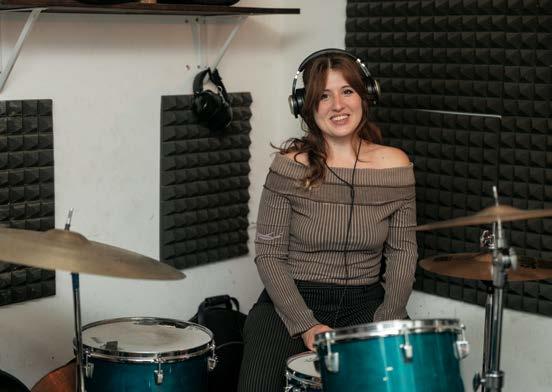
When data analyst Juliette Rando ’15 isn’t working to uncover the mysteries of the brain, she’s merging art and activism in her band Eraser. BY PATRICK
RAPA
“I think it’s very powerful to be succinct,” says Juliette Rando of her band’s music. “We’re not trying to take up too much space, but we do have something to say.”
By day, Juliette Rando ’15 works in an environmental epidemiology lab at Drexel University, sorting through large data sets related to autism.
By night, she can be found behind a drum kit with Eraser, a fiery Philly band that just released their first record, Hideout, on stalwart Philadelphia independent music label Siltbreeze.
Whether she’s analyzing data or keeping a beat, you could say Rando’s job is to maintain a level head when things get noisy. “It’s nice to make order where there was chaos before,” she says.
Rando, who grew up in the Boston area, was a biology major with a neuroscience minor at Haverford, and went on to get her master’s in public health from the University of Pennsylvania.
At the A.J. Drexel Autism Institute—where she’s pursuing another master’s, this time in data science—she works with a team studying the influence of diet and environment on neurological development. She’s “still doing the science thing,” as she puts it, “but not pure bio-wet-lab-pipetting stuff. More like data analysis.”
“I basically spend a lot of time cleaning and or-
we didn’t live in a society that’s extremely stigmatizing of people with any disability.”
In the four years she’s worked at the Autism Institute, Rando has seen strides made, including new studies that examine ways to improve the lives of people with autism, and efforts to include people with autism on advisory boards to offer feedback and insight. There’s plenty of research to be done, she points out, on subjects like comorbidities, connections to gut health, and more. “Wouldn’t that be a much more respectful and worthwhile use of research funding”—better understanding and improving the lives of people with autism—“rather than preventing them from existing?”

ganizing data, and creating data sets from large, messy databases. And then I’ll run different statistical tests based on what my outcome is and what my predictors are,” she explains. “It’s just very satisfying to do. It’s very relaxing.”
That said, Rando is wary of the ways such data could be misunderstood or misused. “If a study shows, for example, that eating red meat in pregnancy is associated with your child having autism, is there now going to be a panic and people avoiding eating red meat because they don’t want autistic kids? That’s a horrifying eugenics takeaway from the research.”

Simply understanding brain development, she says, “would be a wonderful goal and mission—if
It’s no surprise Rando has some strong, well-enunciated opinions on ethics. For one thing, she went to Haverford. For another, she volunteers with the Human Rights Coalition, which advocates for prisoner rights and an end to mass incarceration. For a third, she’s in Eraser—a brash and bratty dance-punk band that wears its heart on its sleeve.
“I do a lot of community organizing on the side, and it’s always been kind of separate from my music stuff,” says Rando, who has played in several Philly bands, including Corey Flood, which generated a bit of national buzz before splitting up during the pandemic era. “It’s really meaningful to have it coalesce.”
The first song Eraser ever released was on a 2024 compilation called No Occupation: Another Benefit for Mutual Aid in Gaza, and that outspoken vibe continues on Hideout. Led by drywitted singer and synths player Sonam Parikh, muscular empowerment anthems “Simon Says” and “Talk to Me” bring to mind trailblazers from the early ’90s Riot Grrrl era.
The eight-song, 15-minute-long release was recorded in Rando’s mom’s therapy office in Western Massachusetts and released in March 2025. “I think it’s very powerful to be succinct,” says Rando. “We’re not trying to take up too much space, but we do have something to say.”
Jo Vito Ramírez ’13 brings a scientist’s curiosity to a multifaceted arts career.
From children’s theater at the Arden to Shakespeare in Clark Park to roles with some of the city’s most artistically adventurous figures and troupes, including Whit MacLaughlin, Headlong Dance Theater, and FringeArts, among others, actor and artist Jo Vito Ramírez ’13 (they/them) has pushed the boundaries for more than a decade in the Philadelphia theater scene.
In February, Ramírez wrapped up a mainstage run in the title role at Arden Theatre Company’s Peter Pan, and more recently served as assistant director for the company’s children’s production of The Hobbit.

my major to theater to focus on the playful act of creation.”
“I’d never directed on such a large scale, so I asked if I could assist the director, Becky Wright,” says Ramírez, who’d been directed by her once. “I knew I’d learn a lot from her.”
It’s an example of what’s become a recurring theme in their career: constant learning through pushing into new forms of artistic expression. For example, Ramírez is currently focused on painting and music making. “What’s most important to me as an artist is to stay curious and to continue to challenge myself, which often means trying new media,” says Ramírez, speaking from their home art studio in Germantown. “Often, I’ll pick up a new medium and find it has something to teach me about my artistic practice in general.”
Their current project is a 3 feet by 3 feet landscape painting combining an interest in Roman history (Ramírez’s mother and grandmother live in Calabria, Italy) with a portrait of Ramírez wearing the hairshirt of St. John the Baptist (it’s an homage to Renaissance compositions). “I didn’t have any training in painting and I think that’s one of the reasons I enjoy making art so much. In some ways, it can be extremely foreign to me, but feel so close to home.”
A QuestBridge College Prep Scholar from the Bronx, Ramírez attended high school at the borough’s Collegiate Institute for Math and Science, then came to Haverford to study astrophysics and minor in theater. “There was very little in the way of art at my high school,” says Ramírez, who started a drama club there after dabbling in theater in junior high.
At Haverford Ramírez realized that the hard sciences weren’t a strong suit, so they shifted to sociology while taking theater classes at Bryn Mawr. “Junior year I decided I’d much rather write and direct a play than write a sociology thesis, so I shifted
Ramírez was especially inspired by two professors in the Bryn Mawr-Haverford Bi-College Theater Program: Professor Mark Lord, with his rich academic view of theater practice, and Associate Professor Catharine Slusar, who most influenced Ramírez’s artistic practice.
In a Lord course on playwright Samuel Beckett, for example, Ramírez learned that Beckett, a native English speaker, challenged himself by writing in French. It’s a technique adapted by Ramírez, who’s currently playing instruments they’re not familiar with, including harmonica, cello, and the chord organ, and composing music in what they call an earnest, playful, and contemplative style.
“Art can be a practice in pretension—you can try to impress people and make it purely with the audience in mind,” explains Ramírez, “but I feel like I have this one precious life and I ought to continue to play and challenge myself and fail, because that’s the best way to learn.”
Making a life in the arts, Ramírez admits, is challenging. “With the recent [proposed] defunding of the National Endowment for the Arts (NEA), I’m hyper-aware that it’s important for artists to come from every class in our society, and I encourage artists who aren’t particularly wealthy—who are scraping it together as I’ve had the challenge and delight, at times, to do—to be gentle with yourself and rely, when possible, on a strong artistic community.”
–Anne Stein
Ramírez is also part of Theatre Contra, which stages movie readings at Philadelphia-area bars. Ramírez’s paintings, poems, handmade furniture, and other creations can be seen at jovitoramirez. com. Their first album, There Is No There There, by Jo Vito and the There There, is available on Spotify and other music sites.
When Alex Gendzier ’84 talks about how U.S. veterans are too often deserted by government programs, his voice rises. Ask him, though, how we can help veterans better reintegrate into society after they’ve served their country, and his tone takes on a more sympathetic lilt.
Gendzier recognizes the challenges veterans face in refinding purpose after their military service, which is a core theme in his book, co-authored with former Navy SEAL Rob Sarver. For Warrior to Civilian: The Field Manual for the Hero’s Journey (Balance/ Hachette), they spoke to hundreds of veterans, coaches, health professionals, pastors, and others to craft a guide mirroring the popular literary archetype of the hero’s journey, riffing off Gendzier’s ancient Greek and Native American studies at Haverford.


Based in New York and Dallas as the general counsel and chief compliance officer at Sycamore Tree Capital Partners, Gendzier began to tinker with ideas for the book when his older son told him he was going to enlist. “I wanted him to have something in that moment because I was aware that the transition to civilian life for most veterans is extremely difficult,” he recalls. “And when he gets out, I may not be around.”
Gendzier spoke to Haverford’s David Silverberg about the many ways veterans can find purpose after they’ve fought for their country and lean into the learning curve of becoming a civilian again.
David Silverberg: What are some of the main challenges veterans face when they return to their civilian lives?
Alex Gendzier: Putting aside healing from wounds that can be deep, whether visible or invisible—the number one issue that comes up over and over again is the search for a new identity, a new sense of purpose in life. The fundamental issue is coming to grips with the
idea that you no longer have a cause in uniform that is transcendent to you or the country.
There’s this phrase from the military, “You have to fight as hard inside the wire as outside.” So outside the wire is combat. Inside the wire is home or your base. And how do you do that in a way where you can live? Not as someone with two different realities or life experiences, but a combined new one. And if you do that, you can find great new meaning in your life journey and self-narrative. You develop a chance to lift up those around you, such as your family, your friends, your community, your country. That is what the hero’s journey is all about.
DS: A Deloitte survey found that about one in three American veterans say the military prepared them somewhat well for transitioning to civilian life, and four in 10 said the military didn’t prepare them too well. What’s your reaction to this finding?
AG: The transition to the military is an enormous one. It becomes your entire sense of self and purpose. But nothing in the military is meant to prepare you upon exit. It’s not what it’s there for.
The Department of Defense with the Veterans Affairs Department and the Department of Labor have run a program called the Transition Assistance Program, available within each branch the military, and we have studied them, interviewed dozens of people about them. And it’s a failure. The instructors are well-intended people, but they end up viewing this as a resume-writing and fast job-placement endeavor. Veterans do need jobs. And there are many companies looking to make a buck placing veterans into jobs, but they miss the point and do damage with rushed and ill-advised placements just to say they did. What’s the proof? The statistics don’t lie. On average, within one year, 44 percent of veterans who get a job leave the role, and by the second year, that figure reaches 80 percent.
DS: Your book includes a chapter on the role that families of veterans can play in this transition. Why did you include that section?
AG: It’s an issue of enormous importance that is overlooked in our country. Families, like veterans, don’t prepare in advance for that change of purpose
and identity. There’s a lack of preparation of where to live, what job to get, how this transition affects children. And the transition they undergo is as important and as challenging as that of the veteran.
For example, there’s a spike in divorce rates among families once the veteran separates from the military, and the truth is, it’s due to inadequate planning, not communicating effectively, and not having coaches to help them.
DS: A chapter I didn’t expect to see was one focused on plant- and psychedelics-based therapy for veterans.
AG: We struggled with this inclusion because it’s a very controversial topic. But we encountered story after story of those dealing with different forms of injury, whether from Iraq or Afghanistan service, whether through traumatic brain injury or PTSD, and how they have lost hope. Some have found help with psychedelics and plant-based remedies where no conventional remedy made a difference.
There is a disproportionate amount of negativity and cynicism around these therapies. But there is a lot of new, cutting-edge work being done in this area. We’re not talking about going to the corner bodega to get high, we’re talking about responsibly supervised, science-based programs.
DS: I read that you believe Warrior to Civilian also has lessons to share with those who were never involved with the military.
AG: It’s a book that has universal appeal. This is not just for veterans but also for the guy that loses his wife to cancer who has to raise two children by himself. And then those children go off to college to have lives of their own. And that guy then has to find a new job in his 50s. Well, that’s me. And all those moments are huge life transitions. I am not unique. Everyone has momentous life transitions. We civilians have inspiring lessons to learn from the heroes’ journeys of veterans. In these stories and our own, one can find great nobility of purpose, dignity, joy, and love.
David Silverberg is a journalist and writing coach in Toronto who has been reviewing books and interviewing authors for more than 15 years.
KIRSTEN MENGER-ANDERSON ’91: The Expert of Subtle Revisions (Crown)

In her debut novel, MengerAnderson has crafted a time-travel mystery infused with mathematics, memory, and identity set in 2016 California and 1930s Vienna. In Half Moon Bay, Ca., Hase, who spends her spare time editing Wikipedia entries, investigates her father’s disappearance as cryptic clues lead her to a machine: some sort of music box rumored to hold the power of time travel. At the same time, mathematician Anton Moritz navigates Europe’s intellectual circles as fascism rises and World War II looms. Deemed “an appealing intellectual mystery” by Publishers Weekly and featured in the Washington Post’s notable books for March, The Expert of Subtle Revisions plumbs the complexities of time and the narratives we construct for ourselves.
RICHARD STEELE ’74: Ambassadors in Chains: Four Christian Prisoners of Conscience (Cascade Books)
In Steele’s compelling study, he profiles four Christians— Perpetua of Carthage, Maximus the Confessor, Thomas More, and Martin Luther King Jr.—from vastly different eras who were all imprisoned for their opposition to unjust state policies. Drawing on writings and historical context, Steele provides insight into how faith sustained them through incarceration and highlights their continued relevance amid contemporary challenges of authoritarianism and religious nationalism. This book, which Steele worked on for nearly 25 years, is a valuable resource for anyone interested in social ethics, penology, or prison ministry.

JED BRODY ’96:
The Joy of Quantum Computing: A Concise Introduction (Princeton University Press)
In his latest work, Brody offers an engaging and accessible exploration of quantum computing, exploring its foundational algorithms and applications while distilling the field’s complex concepts into a digestible narrative that requires only a precalculus background to understand. Brody’s concise volume is an educational resource and a philosophical journey into the quantum realm, proving that quantum information science is much more than high-speed calculations and data security.

LINDA GAUS ’87 (TRANSLATOR):
Huts Full of Character: 52 Charming Huts in the Alps (Schiffer Publishing)

This vivid photographic guide, which Gaus translated from German, invites readers to explore 52 charming huts nestled in the Alps across France, Switzerland, Italy, Germany, Liechtenstein, Austria, and Slovenia. The rustic retreats are an important part of alpine culture, offering food, accommodation, and stunning views. Gaus’ translation brings the charm of these mountain havens to English-speaking audiences and armchair adventurers. No passport or hiking boots needed.
DAVE BARRY ’69:
Class Clown: The Memoirs of a Professional Wiseass: How I Went 77 Years Without Growing Up (Simon & Schuster)
The longtime humor columnist takes readers across the arc of his life in prose that’s, yes, funny, but also at turns probing and heartrending. Barry, known for taking almost nothing seriously, gets introspective and philosophical while talking about his family, his early life, and the various stages of his career, right through his decisions to quit his

long-running column and eventually write a memoir. Barry’s time as a Ford features prominently: He recounts naming his college band, Federal Duck, after a mind-altering experience at the Duck Pond and, as an English major, reading “roughly a third of the way through many great literary works.”
STÉPHANE GERSON ’89 (EDITOR):
Scholars and Their Kin: Historical Explorations, Literary Experiments (University of Chicago Press)

This anthology of 10 essays probes the intricate process of historians writing about their own families. Through a range of writing styles, the contributors explore the give and take of personal narratives and historical analysis while touching on themes of memory, identity, and the complexities of familial research. Scholars and Their Kin provides a new perspective on historiography and the insights that emerge when scholars turn their analytical gaze inward.
MARK RUSS ’75:
The Family Guide to Psychiatric Hospitalization (Johns Hopkins University Press)
Every year, millions of Americans face psychiatric hospitalization, but the process can be stigmatized and cloaked in mystery or misunderstanding. In this guide, Russ, chief medical officer for Silver Hill Hospital in New Canaan, Conn., offers patients and their families critical information to navigate this challenging process. Drawing on his dual perspectives of physician and patient, Russ’ unparalleled understanding of psychiatric hospitalization shapes this guide into a testament to the healing power of compassionate care.


BLYTHE COONS ’01 (CO-AUTHOR): The Motivated Speaker: Six Principles to Unlock Your Communication Potential (Wiley)
Coons and her co-authors have created a practical guide that collates decades of collective coaching experience into six principles for effective communication. By drawing from their backgrounds in theater and executive coaching, the authors provide insight into the necessary habits and mindsets to empower speakers to connect with their audiences authentically. The Motivated Speaker is a valuable resource for professionals looking to enhance their speaking skills and perform like superstar TED speakers and Fortune 500 leaders.

JONATHAN GROSS ’85: The European Byron: Mobility, Cosmopolitanism, and Chameleon Poetry (Anthem Press)
Gross, a professor of English at DePaul University, examines how Lord Byron’s literary persona was informed by European writers like Thomas Moore, Percy Shelley, Torquato Tasso, and others. The European Byron seeks to better understand Byron’s concept of “mobility” by highlighting the various cultural identities and literary styles he adopted. Gross also ties Byron’s influence to Slavic poets, demonstrating his impact across boundaries and the 19th century’s literary landscape.

DAVID FELSEN ’92: New York City Monuments of Black Americans: A History and Guide (The History Press)
Felsen’s guide is a thoughtful exploration of the New York City monuments honoring Black Americans. While tracing the evolution of the city’s monuments—from the nameless symbolic figure depicted
in Brooklyn’s Green-Wood Cemetery to the first monument dedicated to a Black woman, Harriet Tubman—Felsen, an 11th-grade history teacher, provides context and insightful narratives for 30 sites. Felsen takes great care to highlight stories of triumph over great adversity to provide a deep understanding of New York’s rich Black history.
ROBERT WHITE ’69: Bad Fathers, Wicked Stepmothers, Cannibalistic Witches, Amorous Princes: The Psychoanalytic Study of Fairy Tales (Ethic International Press)

Through his scholarly examination, White probes the psychological themes of classic fairy tales through Freudian theory and psychoanalytic critique. White explores the themes of desire, repression, and parental ambivalence featured in these seemingly simple stories to reveal the emotional structure encoded within them. Featuring both accessible prose and clinical insight, the book is a fitting read for scholars, mental health professionals, or anyone interested in the darker themes coursing through classic childhood stories.

WILLIAM W. MALANDRA ’64: The Bundahišn: Translated With Commentary (Journal of Indo-European Studies, Monograph No. 68)
Malandra’s scholarly work is an in-depth English translation of the Bundahišn, an important Zoroastrian text that details ancient Iranian cosmology. Completed just before the Arab conquest of Iran, Bundahišn is a record of pre-Islamic religious thought. Malandra’s commentary throughout helps unravel complex passages and places the text within broader literary and religious traditions.
FORD AUTHORS: Do you have a new book you’d like to see included in More Alumni Titles? Please send all relevant information to hc-editor@haverford.edu.
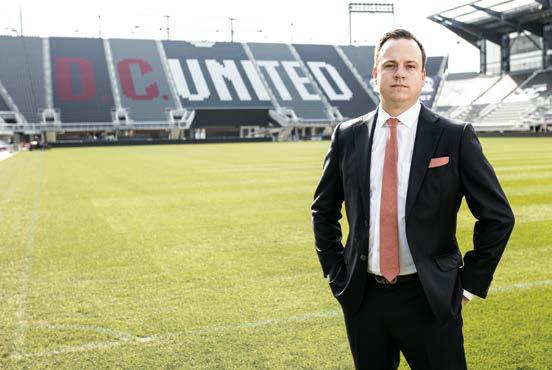
When Jordan Stuart ’05 played soccer for Haverford, he was all about defense. Now he’s focused on setting—and reaching—goals as an owner of two professional teams in the burgeoning U.S. soccer ecosystem.
BY CHARLES CURTIS ’04
Jordan Stuart ’05 never dreamt, when he was running up and down the pitch as a defender for Haverford’s soccer squad, that he’d someday be an owner in the sport he loved.
But that’s where the political science major and Bryn Mawr, Pa., native finds himself today, a part-owner of not one but two professional soccer franchises. First, there’s Loudon United FC, a men’s team based in Leesburg, Va., that competes in the United Soccer League Championship (a second-division league beneath Major League Soccer [MLS]). Then there’s the DC Power FC, a women’s team in the nation’s capital that plays in the top-tier USL Super League (it’s on par with the National Women’s Soccer League).
There he serves as club president, having built the team from the ground up after it was founded in 2024 and signed up big-name investors including WNBA star Angel Reese and MLB All-Star Josiah Gray.
So how did he make his way into sports ownership? He told Haverford about how he got here, his big eureka moment, how he juggles multiple jobs at once, and what it means to be involved in soccer as the men’s and women’s World Cups come to the United States in the next several years.
His love of soccer began during the last U.S.-hosted World Cup. In 1994, I was 12, and there was a soccer subculture growing when the
World Cup was here. You started to have talented kids coming together on these travel teams. I was a defender because I couldn’t score. I was a forward for most of my high school career, and then coaches told me there was no such thing as a defensive forward: “If you can’t score, you’re not playing this position.” I took a lot of pride in shutting down scorers from other teams, and that’s what I spent my four years doing at Haverford.
The path to ownership began in real estate. After graduation, I worked in consulting and government contracting in Washington, D.C., but I got my real estate license when I was 24. While sitting in a cubicle in 2014, I had an epiphany. I asked myself: What’s a value-add for me that’s also an entry point for the love of sports I had while growing up outside of Philadelphia? The answer: I started finding housing for pro athletes who were new to the city. I ended up working with every major pro sports franchise in D.C. This led to my current role as the director of sports and entertainment real estate for Keller Williams Realty, where I help athletes and entertainers with real estate needs across North America.
His D.C. soccer connection was made thanks to an all-time great. In 2018, I worked with former England national team captain and new D.C. United signee Wayne Rooney to find him and his family a place to live. That’s how I became close with the owners of the MLS club. They realized I was this independent third party who could bring minority investors into the club, and so I got all kinds of big names to be part-owners: NFL running back Mark Ingram, B.J. and Justin Upton from Major League Baseball, and others. The owners saw I was good at it, so they told me they wanted to give me an opportunity to invest, too. So I invested in Loudoun United FC, which used to be a D.C. United affiliate. A year later, I was asked to be the first club president of the DC Power FC, while also becoming a ground-floor primary investor.
Building a sports franchise from the ground up goes beyond the product on the field. With any grassroots team in its inaugural season, you want a brand identity and you have to field a team, so I was heavily involved in all of that. We had to begin by focusing on our three revenue streams: sponsorships, ticket sales, and consumer products. But we also had to figure out how to sign players and how to get them housing, medical benefits, and so on. Building out the infrastructure of a team before hiring a coach? That’s very difficult. I oversee all day-to-day operations of the team, communicate with players, agents, the league, housing reps. … It’s the most complicated situation.
How the Haverford experience helped on and off the field. You need to have experience and a love for the game, an entry point into the sport where you can tell how one player is 10 percent better than another. But there’s also living that life, practicing every day then going to a philosophy class. It forces you to multitask and pay attention to different things. Also, I wrote so many papers that helped me improve my writing. I think my biggest strength now is writing a succinct email and getting my point across.
The 2026 World Cup is a huge opportunity.
With the men’s World Cup coming to the U.S. next year and the women’s World Cup here in 2031, that’s going to bring a lot of eyes to the sport, as well as a lot of money. I’m creating relationships—not to just produce a winning team, but to bring in sponsors who may have been focused elsewhere. I’m at the forefront of showcasing why our teams and leagues should be relevant. We’re building out the game at every level.
Charles Curtis ’04 is managing editor for USA Today’s For the Win and an author of the Weirdo Academy series, published by Month9Books.
Get updates on your favorite Haverford teams on X (@HCFords_Sports) and Instagram (@HCFordsSports), or visit the Athletics Department website at haverfordathletics.com.
‘‘ At Haverford, I wrote so many papers that helped me improve my writing. I think my biggest strength is writing a succinct email and getting my point across. ”
BY CURRAN MCCAULEY
In the 2024–2025 season, Haverford came to play. Across every playing surface, the College’s student-athletes contributed to one of the most triumphant seasons in recent history. Fords not only notched conference wins and playoff berths, they set new records and garnered national recognition. But success wasn’t limited to competition. Many studentathletes collected academic honors that reflect the College’s commitment to excellence on the field and off. These are just some of the high points of Athletics’ triumphant year.

◄ Eric Chen ’27 became the College’s first-ever U.S. Fencing Coaches Association Division III Men’s Epee Athlete of the Year. The two-time Division III All-American was the only men’s epeeist in that division to qualify for this season’s NCAA National Collegiate Championships in April, where he placed 22nd against athletes from all three NCAA divisions. Chen also won the NCAA Elite 90, awarded the student-athlete with the highest GPA at each championship site.
Fresh off his 2025 Centennial Conference Track Athlete of the Year honors, Reza Eshghi ’25 received All-American honors in the indoor 3,000-meter and oudoor 5,000-meter events. In cross country, Eshghi placed 191st in 25:43.9—an 89-place improvement from 2023. Peter LaRochelle ’25 ► earned Second Team All-America honors in the outdoor 10,000-meter with an 11thplace finish. In cross country, the 2025 Metro Region Runner of the Year earned his second consecutive All-America honor with a 40th-place finish at the 2024 NCAA Division III Cross Country Championships, clocking 24:46.4. Both distance stars conclude decorated collegiate careers marked by multiple NCAA appearances, regional titles, and academic accolades.
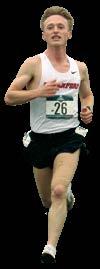
After finishing with a program-best 15 wins, Women’s Lacrosse was ranked No. 17 nationally and earned its first-ever NCAA tournament victory. The team’s success was driven by a dominant trio of All-Americans: Brooke Epstein ’26, Tiffany Mikulis ’25 Eva Baumann ’25. Epstein led the Centennial Conference in goals, points, and draw controls, setting multiple program records in the process. Mikulis, a three-time All-Centennial pick, surpassed 200 career points. Baumann anchored one of the conference’s top defenses with 28 caused turnovers.

After going undefeated during its spring regular season, Cricket marked its best result this century at the Philadelphia International Cricket Festival in early May by finishing as the runner-up. Led by Sidd Phatak ’25 ► and Mohanish Bajaj ’25, the team combined aggressive batting with disciplined bowling.
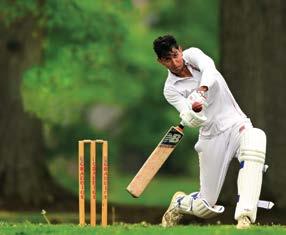
WOMEN’S SOCCER’S standout campaign included its first 10-plus win season and Centennial Conference playoff appearance since 2019. MEN’S LACROSSE finished its season with nine wins, the most since 2011. VOLLEYBALL clinched a spot in the Centennial Conference Championships as the No. 5 seed, marking its 20th postseason appearance in the last 24 years.


Men’s Tennis Men’s Tennis capped a historic 2025 season finishing 16–6, tying the program record for wins, and securing national (No. 16) and regional (No. 4) rankings. The Fords reached the Centennial Conference final for the first time in over a decade and returned to the NCAA tournament for the first time in nearly three decades, where they notched the program’s first-ever firstround win. Coach Eric Spangler was honored as the Intercollegiate Tennis Association Atlantic South Regional Coach of the Year, while six players earned All-Centennial Conference recognition and four received College Sports Communicators Academic All-District honors.
Baseball The Fords reached the Centennial Conference championship series for the first time since 2019, thanks to a stunning playoff run that included a 6–5 win over McDaniel College and a jaw-dropping 24–10 victory over Swarthmore. Second baseman Harry Genth ’25 ▼ earned Perfect Game’s Division III Co-Player of the Year honors, broke multiple Haverford single-season and career records, and positioned himself as a major league prospect by leading Division III in slugging percentage, home runs, and RBIs per game. Standout shortstop Jackson Sgro ’27 was named D3Baseball.com National Rookie of the Year, leading the Centennial Conference in batting average and finishing among the top 20 nationally in home runs and RBIs.


Field Hockey Field Hockey earned its 19th consecutive National Field Hockey Coaches Association National Academic Team Award, ranking second in the nation for cumulative GPA. Twenty-four student-athletes made the Division III National Academic Squad—tied for second-most nationally—and six were named Scholars of Distinction. The team capped its season by securing a Centennial Conference playoff berth in dramatic fashion: back-to-back shootout wins, including an upset over nationally ranked Swarthmore. Clutch saves by rookie goalkeeper Steph Ionescu ’27 propelled the Fords into the tournament for the third time in four seasons.

At the 129th Penn Relays, Haverford Women’s Track and Field scored a thrilling victory in the Centennial/MAC 4x400meter relay. Clocking a seasonbest 4:00.88, the Fords’ squad of ◄ Dominique La Grenade ’25, Olivia D’Aulerio ’26, Adriana Cruz-Soto ’27, and Anastasia Jaycobs ’27 secured the 10thfastest time in program history.
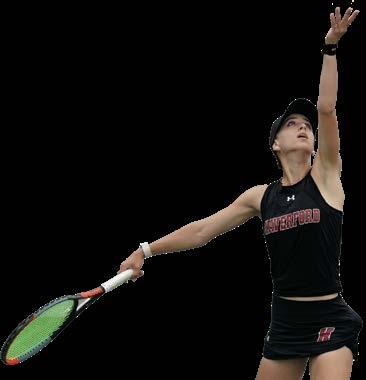
Women’s Tennis Rachael Fitzgerald ’25► capped her Haverford career by qualifying for the NCAA Division III Women’s Tennis Championships in Claremont, Calif., making her the sole Centennial Conference representative in the individual draw. Fitzgerald finished the season with a 12–6 record in dual matches, going 7–1 in conference play.

Leighton Rice ’06 comes by his passion for apples honestly. After more than 20 years at family-owned Rice Fruit Company in the mountains north of Gettysburg, Pa.— where he worked first as a farmer and now works as vice president of quality—he still loves apples. Loving apples, he admits, is essential to success in his day-to-day work. It doesn’t hurt that he’s also an unapologetic micromanager. Yet, Rice has a philosophical edge, one born, perhaps, of his experience as a religion major who especially enjoyed his philosophy and history courses.
Rice, who sang tenor in the Chamber Singers of Haverford and Bryn Mawr Colleges, spent a transformative semester abroad in Salamanca, Spain, and one summer as an aide in a kindergarten class. The other three summers, he worked his family’s 700 acres of orchards, driving tractors and performing all manner of farm labor. “I thought that made me a tough guy,” says Rice. “And I liked being outside, away from the noise and the people and the stress.” As he grew into his VP role, he also took on the title of inventor/entrepreneur with a start-up product, StemPunk.
Rice Fruit Company started in the early 1900s selling apples at local stores. By the 1950s, it emerged as an East Coast powerhouse of storage, marketing, and packing that ships roughly 2 million boxes of apples yearly to grocers such as Walmart and Lidl. Leighton, a father of two, admits his colleagues are sometimes exasperated by his attention to detail. His hyper focus on particulars may have earned him a reputation as a stickler around the factory, but he’s good at what he does, he enjoys his work, and he still makes time to pursue his intellectual interests, currently Civil War history.
What is your current role at Rice Fruit Company?
I’m the VP of quality. I interface with a lot of the other departments. From the moment the fruit arrives, I’m the gatekeeper. Until the apples are shipped, until we load them on the truck and pull the ticket, I’m responsible for quality, and I would say the biggest and most important part of that is overseeing storage—making sure that everything happens correctly, at the right time.
You admit that being a micromanager is what makes you good at your work. Tell us more. It’s just that I’m extremely careful. Rice Fruit Company has a reputation for providing good service and quality. It’s just the sum of all the details, like, it’s not 38 degrees, it’s 37, OK?
And if you’re gonna sink a post in the ground, I’m looking at the perfect angle, and I stand there and watch it go in. It’s funny because I get invited to be on all of these boards and everybody wants me to advise their startups, but none of them seem to realize that I’m specifically unsuited for that kind of thing. What I hate is sitting around in a room and just talking about doing things. I like to actually do things.
Was it a foregone conclusion that you’d join the family business?
‘‘
I’m the gatekeeper,” says Rice. “Until the apples are shipped, until we load them on the truck and pull the ticket, I’m responsible for quality. ’’
My dad never tried to pressure me to join the fruit industry, as I think he secretly wanted to do something else. He wanted to get into law and politics, so he was disappointed when he couldn’t talk me into going to law school. I would not have been a good lawyer or doctor, and probably not a good politician either.
As pragmatic as you are, you also have a spiritual, meditative side. Did your religion studies contribute to that?
My coursework was heavy to the humanities, obviously, but the real standouts were the off-the-beaten path interests and experiences that grew from my coursework. I remember doing some research for an Islam class with Michael Sells. I started reading through this little book of poems by an Indian mystic poet from the 15th century by the name of Kabir. It was magical, transformative, like, I walked out of there feeling like I was stepping into a world that was entirely different than the one that I left when I entered the library six hours earlier. It was the feeling that things were suddenly much brighter and alive and that life would never be the same again. And in a way, I can say that life never was the same again.
Tell us about your role as inventor. StemPunk is a tool for fruit growers to use to improve the quality of the fruit they deliver. The [untrimmed] stem on an apple can damage other
apples in the same bin. StemPunk allows pickers to pick almost as fast but still trim the stems down. Although StemPunk is no longer active, I co-founded Daxo Industries and we recently concluded trials for a new stem-clipping tool called Zapper.
Has climate change affected the apple business?
Yes, unequivocally. It’s not so much warming as it is the unpredictability and the extreme nature of the weather. For example, every other year, it seems, we get the remnants of a major hurricane that blows through literally at the worst time of year—right in the middle of first pick on Honeycrisp. We get this huge shot of rain, like four inches in a day. The roots suck that up really fast and the cells swell which causes cracking. A few years ago, we had forecasted a high volume of high-quality Honeycrisp for customers, and then our estimates were reduced by 80 percent in a week.
Although you ship over two million boxes of apples yearly, how does a small, family-owned business compete with the big producers? You have to be able to provide this critical mass on key varieties in order to stay relevant, because even though we’re huge on the East Coast, there are sheds in Washington that ship 10 times as many boxes for lower prices. It would be much easier for a big retailer to cut ties with us and consolidate. But they still respect these long-term relationships and “grow local” is important to them on some level. But, I would say that we’re only one upper-level re-ordering of management from oblivion.
For the fruit lovers, what is your favorite varietal?
Ambrosia, Evercrisp, and Lemonade. I’m gonna plug Lemonade. It’s one of our club varieties that’s both sweet and lemony. You might see it at local Lidl stores in late fall and winter.
—Hillary O’Connor

How one alum’s journey with Parkinson’s disease is fueling ethical inquiry in Haverford’s blossoming neuroscience program.
By Dominic Mercier
Shamir Khan, Ph.D. ’96 was strolling through Manhattan when he found himself consciously swinging his left arm as he crossed New York’s streets and sidewalks. He’d never experienced that before. Unfazed, he chalked up this new, deliberate movement as a moment of overthinking. But he’d later come to realize that the nearly imperceptible change in his gait was another in a series of subtle clues that would lead to a life-altering diagnosis.
After that walk, Khan consulted his primary care physician, who wasn’t initially concerned but humored him with a referral for an MRI. Though the imaging came back “within normal limits,” two neurologists eventually diagnosed early-onset Parkinson’s disease.
Suddenly, the bodily quirks Khan had observed in himself over the years were anything but.
For instance, it wasn’t some kind of right-sided dominance that prompted Khan’s personal trainer to add more weight to his right side during their workouts, nor was it a simple matter of bodily asymmetry or imbalance that once led a swim instructor to note how much faster Khan’s right foot moved compared to his left. Just 44 years old at the time of the diagnosis, the news was a gut punch. Of the nearly 1.1 million people living with the relentless and incurable Parkinson’s disease in the U.S., only 10 to 20 percent experience symptoms before age 50, according to the Michael J. Fox Foundation.
By that point, Khan had built a life that, by any

objective measure, could only be viewed as highly accomplished and flush with purpose. Married and a father to two boys, he nurtured a thriving Midtown Manhattan psychology practice. His services were so in demand that some patients would fly in from across the country for short, intense treatments. At Columbia University, where he’d completed his graduate work, he served as an adjunct professor in the university’s psychology Ph.D. program and taught a foundational course on ethics.
Everything was moving in accordance with the plan he had envisioned for himself and his family. Until it wasn’t.
“As the disease progressed through those first few years, it started eroding the roles that defined me,” Khan recalls. “Parkinson’s encroached on my clinical practice. I reduced and eventually had to close my patient caseload. Teaching, which I had loved,
became physically exhausting. Stepping back from these professional roles felt like surrendering pieces of my soul.”
For someone who thrived on structure—he was well known at Columbia as a professor who favored lengthy, color-coded syllabi—Parkinson’s injected radical unpredictability into his life. Completing routine tasks like tying his shoes would be a cinch one day, nearly impossible the next. The emotional impact, too, was devastating.
“Imagine waking up each morning unsure if your legs will cooperate, if your meds will work, or if you’ll be able to enjoy something as basic as an ice cream cone,” Khan says. During sleepless nights, he’d lie awake worrying about the rest of his life and the indelible psychological marks Parkinson’s would leave on his family, especially his sons, as they watched his inevitable diminishment. Yet Khan, the psychologist, reframed his circumstances: Instead of a steady, ceaseless decline, he committed himself to viewing life as an unpredictable expedition.
“This wasn’t naïve positivity. It was my survival strategy,” he says. “Even though the psychologist-me knew I was using a classic cognitive behavioral coping mechanism, the patient-me desperately needed it.”
His new outlook, which he dubbed his “adventure mindset,” served him well until Parkinson’s forced a second reckoning in early 2024. Now living in Belgium, he could no longer function independently on medication alone. Walking steadily, eating, and typing were extremely difficult. His neighbors and friends would check on him while his wife, Malini Moorthy, a lawyer who currently serves as general counsel for a biotech company, was at work.
A major turning point came that February, when Khan underwent the first of a trilogy of surgeries to implant electrodes into both hemispheres of his brain and a pulse generator in his chest. The technology, deep brain stimulation (DBS), pioneered by the medical giant
PARTNERS IN PROGRESS: Malini Moorthy and Shamir Khan, Ph.D. ’96, the namesakes of Haverford’s new Khan–Moorthy Neuroscience Research Fellowship, in Belgium.
Medtronic, delivers impulses, much like a pacemaker does to a heart, that regulate brain activity and ease the side effects caused by his medications. For Khan, the transformation was nothing short of life-changing, this time for the better. In April 2025, he received a cutting-edge upgrade to his implant, which utilizes artificial intelligence to monitor brain activity in real time, enabling on-the-fly adjustments.
“Physically, the transformation was almost immediate. Emotionally, it was as if someone lit a candle in a dark room,” Khan says, recalling being brought to tears as he watched his left hand keep up with his right as he completed the everyday task of tapping out an email. “After years of progressive decline, I experienced recovery. I use that word carefully—Parkinson’s is still with me, and I’m not cured—but the post-surgery months have truly been a recovery of self.”
As his hands steadied and he reflected on the ethical foundation his days at Haverford had instilled in him, a new question began to surface. How could Khan transform the gift he had been given into a gift for others, especially the next generation of scientists and professionals eager to unravel the mysteries of the brain?
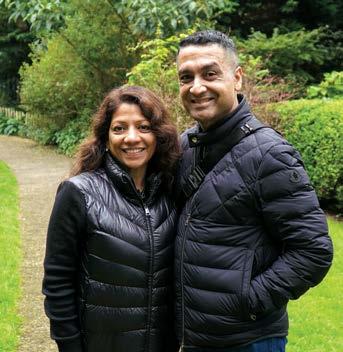

PATHWAYS Reinvigorated and inspired by the medical advances and research fueling his “second act,” Khan, during a speech at a Medtronic holiday party last year, announced a new fellowship at Haverford that would transition him from beneficiary to benefactor. Though the details weren’t fully realized at the time of his announce ment, Khan, as he stood before a crowd responsi ble for giving him his life back, recalls feeling deep gratitude and intense commitment burning within.
“Physically, the transformation was almost immediate,” says Khan of his first experience with deep brain stimulation. “Emotionally, it was as if someone lit a candle in a dark room.”


“My wife, who is my partner in all things, had been discussing this with me in depth: How do we encourage more brilliant minds to enter this area? How do we ensure ethics and humanism are part of the scientific journey? We both felt a sense of urgency,” Khan recalls.
The resulting Khan–Moorthy Neuroscience Research Fellowship, which was awarded to its inaugural recipient, Olivia Davis ’27, in May, is a perfect fit for the College, where neuroscience has exploded in popularity and a deep immersion in ethics remains a hallmark of a Haverford education. The fellowship guarantees annual support for at least one student to conduct research on neurodegenerative diseases through a summer experience at the College. As an endowed fellowship independent from the current uncertainties of federal grants, the opportunity is especially valuable in today’s scientific research landscape.
But it’s not just the financial model that distinguishes it; Khan hopes it will help students get involved early and consider career specialization to help mend what he sees as a “broken pipeline” of movement disorder specialists. Neurology, he says, can be a difficult field, both emotionally and administratively, and movement disorder specialists are asked to confront progressive diseases with no cure. Historically, it’s also not among the highest-paying specialties, which can prompt a difficult decision when weighing medical school bills.
“The idea is to nurture interest long before med school debt and career pressures narrow their options,” Khan says. “We want them to catch the ‘bug’—to see how fascinating and impactful movement disorder work can be—and carry that forward.”
Fixing that pipeline is paramount, Khan says, as studies predict the number of Americans diagnosed with Parkinson’s will increase by roughly 10 percent,
board-certified movement disorder specialists available to help them remains lacking. Studies have also shown that about 40 percent of Parkinson’s patients have never even seen a neurologist, and many U.S. states have fewer than five specialists available for thousands of patients.
“Shamir is an incredibly special person who is extremely motivated, not just for improving his own condition, but also making things better for others,” says Associate Professor of Psychology Laura Been, a behavioral neuroendocrinologist and director of the neuroscience program for the past decade. “I really think he wants his experience to have a greater purpose that shows others what’s possible because of research and science.”
AND
When the Bi-Co neuroscience major launched in 2021, it was the result of five years of careful planning and a response to a need that had been growing organically for years. The program has catapulted into the most popular academic offerings on both campuses, with 101 members of the Classes of 2026 and 2027 from both campuses having declared neuroscience as their major.
“We could tell that the students were really hungry for it,” Been says of the major’s inception. “We also knew that some of our peer institutions had majors as well, and we wanted to be competitive in the broader liberal arts landscape. But I don’t think we anticipated how quickly the major would grow here. We have just been flooded with neuroscience majors, which is a great problem to have.”
While the sheer number of students might be surprising, their reasons for entering the field and playing a role in unlocking the mysteries of cognition, behavior, and emotion are not. For Been, the answer is simple: Everyone has a brain and cares about others who do, too. She notes that so many students arrive at Haverford having been touched
or affected by an issue related to the field, whether it’s parents or grandparents who are living with a neurodegenerative disease or student-athletes who have either sustained concussions or supported teammates as they recover from one.
That intimate personal connection helps humanize science in a way students find very compelling, she says. “They want to be able to make the connections between what they’re learning about in their coursework, what they’re doing in their laboratory research, and then what’s happening to them in their lives. Neuroscience provides a lot of opportunities to make those connections.”
It doesn’t hurt that the College is so close to Philadelphia, a major research hub, which allows students to pursue summer research at top-tier facilities like Children’s Hospital of Philadelphia and the University of Pennsylvania. Been is hoping to strengthen partnerships with Thomas Jefferson University through alums like Chris Farrell ’97 director of neurological surgery, and neurologist Jeff Ratliff ’06
“They’ve reached out and asked, ‘What do you need help with?’” Been says. “That never happens. Nobody but Haverford alums would reach out to ask if you need help with anything or if you have students interested in observing brain surgeries.”
On campus, students are presented with opportu nities to engage in a wide range of research, reflecting the major’s interdisciplinary structure, which draws faculty from biology, psychology, and other depart ments. In Been’s own lab, they explore how hor monal changes prepare the brain as people become parents and how they can also lead to more serious issues, like postpartum depression. They might also be willing to don a cap wired with electrodes with Professor of Psychology Rebecca Compton to mea sure brain waves in search of understanding how adversity affects emotional regulation.
Much like Haverford’s other science programs, the neuroscience faculty prioritizes mentorship, offering opportunities to co-author papers in peer-reviewed journals, present at national conferences, and even design their own research experiences before pursuing medical school or careers in law and tech.
“When our students head off to graduate school or to work in research labs as technicians, I often hear from their principal investigators that they
arrived like third- or fourth-year graduate students,” says Professor of Biology Rob Fairman. “That’s the level that our students are able to operate at.”
In Fairman’s own lab—where Davis is spending her summer as the inaugural Khan–Moorthy fellow—student agency drove the change in focus to neurodegenerative diseases. Fairman, a biochemist by training, arrived at Haverford in 1997, teaching basic biochemistry and how proteins, when they aggregate and clump, affect cells. But it was one of his students, Melanie Smith ’06, who proposed examining more closely the role protein clumping in the brain plays in the development of neurodegenerative diseases.
In the past few years, Fairman and his students made an exciting discovery drawn from an unex-


The resulting fellowship is a perfect fit for the College, where neuroscience has exploded in popularity and a deep immersion in ethics remains a hallmark of a Haverford education.


nematodes shows that tree-derived compounds may slow or protect against neurodegeneration. But as Fairman looks ahead, he’s beginning to turn his attention underground.
“We’ve taken cores from trees to look at the bark and the inner sapwood,” he says. “But I’m particularly interested in the roots because—people don’t necessarily know this—the part of the tree you see above ground, which can live hundreds or even thousands of years, is not really the oldest part. It’s the roots.”
FIT If you ask Khan to describe the ideal recipient of the Khan–Moorthy fellowship, he won’t point to academic accolades or high GPAs. He’s looking for more consequential qualities: “I envision a student who is proactive and driven by purpose. Maybe this student has a personal motivation—perhaps a family member with a neurological condition, or an experience volunteering at a hospital—that sparked their interest in neurodegenerative diseases.”
Khan also envisions a student who embraces interdisciplinarity and is eager to answer deep, scientific questions about the pathology of Parkinson’s, while also being concerned about what happens to data culled from DBS implants like his. Finding a student like that might seem like a tall order, but Davis fit the bill perfectly.
In January 2020, when she was in high school, Davis’ grandmother was diagnosed with Parkinson’s. Since then, Davis, a biology major and health studies minor, has watched her deteriorate and suffer through the side effects of the medications she takes to stave off the disease’s progression. The emotional pain of that deterioration has become more and more acute since Davis started college and trips back home to New Jersey have become rarer.
“I only get snapshots of what [her progression] looks like. But you can see the difference every time. It’s really hard to watch,” Davis says. “That’s what has inspired me from the second I joined Rob Fairman’s lab.”
What changes in the federal funding landscape mean for STEM research at Haverford


NUMBERS GAME: Associate Professor of Mathematics and Statistics Rebecca Everett is among the many Haverford faculty whose federally funded work has helped young Fords find their calling while advancing scholarship.
tor students in ambitious, hands-on work that can be transformative for both. Some of the most rewarding and inspiring moments of my career at Haverford have come from working alongside students on various research projects,” White says. “This funding not only creates opportunities for growth, discovery, and mentorship at Haverford, but also advances research that helps us better understand and respond to the world around us.”
Students agree. “Federal grants allowed me to collect data to test original research questions and to present our research at national conferences,” says Lizy Szanton ’22, who worked with Assistant Professor of Psychology Ryan Lei. Ravenel Davis ’22, who also worked in Lei’s lab and is now a Ph.D. candidate at Cornell University, had a similarly positive experience. “I feel incredibly fortunate to have had the opportunity to engage in such meaningful research as an undergraduate and to have received such strong mentoring and hands-on guidance throughout the process.”
Faculty underscore the impact that such experiences can have on the world’s newest scholars. “Students get opportunities to explore and engage with a wide range of scientific ideas,” says Assistant Professor of Biology Amy Cooke. “Our work has led to one peer-reviewed publication and six presentations at scientific conferences,” she says, highlighting achievements in her lab alone. “In total, 17 Haverford undergraduates contributed to research funded by this award, and 16 have continued in science or medical fields. Of those who have graduated, four are now in graduate programs, six are in medical school, and the rest are working in research while applying to professional schools.”
Professor of Environmental Biology and Environmental Studies Jonathan Wilson has been exploring how faithfully plants respond to, and record, changes in atmospheric carbon dioxide concentration. “We grew Ginkgo biloba trees in high-CO2 chambers,” he says, “and monitored how they responded to this novel atmospheric environment. Understanding how past climate change unfolded is vital to understanding what might transpire in the future. Project alumni are at prestigious Ph.D. programs in the plant or environmental sciences … working with some of the best and most famous scientists in the world.”
Darshan Mehta ’25 echoes many student researchers who’ve participated in federally funded research at Haverford.
“My undergraduate research experiences have been transformative, shaping my academic path and solidifying my career aspirations. They ignited a passion I never anticipated, solidifying my aspiration to make research a cornerstone of my future career.”
—Chris Mills ’82
For more about federal grants in STEM at Haverford, go to hav.to/research. Your financial support can help offset cuts in government funding. Go to hav.to/resilience to make a gift in support of research at Haverford.
A member of Fairman’s lab since her earliest days at the College, Davis, thanks to the Khan–Moorthy Fellowship, has designed her own research experience with Fairman’s guidance. To no one’s surprise, it focuses on the promise of plant extracts, but instead of trees, Davis’ research is centered on a compound called genipin, derived from the Portuguese crowberry shrub.
Davis designed the project herself after noticing a gap in existing literature. The compound had already been proven to extend lifespan and motility in fruit flies; however, no research had been conducted on its effects on sleep. This summer, she’s engaging in a cross-Atlantic partnership with a lab at NOVA University of Lisbon that has previously conducted research on the effects of genipin in fruit flies and yeast.
While the lab work is technically demanding, the emotional and ethical dimensions anchor Davis’ motivation. As she plans to attend medical school and become a surgeon, ethics are at the forefront for Davis, even though her work so far has been focused on tiny model organisms.

“The fellowship’s ethos is an extension of the values I learned in college,” says Khan. “The idea that you must consider the human impact, the societal context, of whatever work you do is pure Haverford.”


“I think medications and treatments that can be life-changing need to be made accessible. That’s really important to me,” she says. “In preparing to become a doctor, I always worry that there will be a day I have to tell a patient ‘no’ because of a big insurance company. I want to be able to give all of my future patients the best care I possibly can.”
In Davis, Khan’s vision for the fellowship has found its embodiment: a student who’s intellectually curious, grounded in ethics, and informed by lived experience. Davis’ work could very well uncover new paths in Parkinson’s research, but more importantly, it’s driven by the kind of compassion that can’t be taught in the classroom or lab.
“To me, training a neuroscientist without ethics is like teaching a pilot to fly without reference to the navigational rules. Sure, they might get off the ground, but it’s dangerous and unsustainable,” Khan says. “The fellowship’s ethos is an extension of the
values I learned in college. The idea that you must consider the human impact, the societal context, of whatever work you do is pure Haverford.”
As Khan says, Parkinson’s will always be with him, but today, he moves through life with a steadiness he worried had been lost forever. Just a few months after his DBS surgeries, he embarked on a trip to Kenya and Tanzania with his family, marveling as he was able to climb into a safari Jeep—a casual movement that would have been unthinkable, even disastrous, just a short time before. He remembers savoring an ice cream cone with his sons last summer, “a mundane joy,” he says, “but it felt like a miracle.”
DBS has returned many things to him, including the clarity fueling his twofold mission: offering hope as he guides others navigating the disorienting terrain of a Parkinson’s diagnosis and supporting the next generation of researchers.




pretty uncommon. The 85 artists who work here, along with 20 at CCW’s smaller space in the South Kensington neighborhood of Philadelphia, are neurodivergent, and CCW is what’s known as a progressive studio.
Progressive studios originated 50 years ago in Oakland, Calif., when an artist and a psychologist launched a radical arts movement aimed at helping people with developmental disabilities thrive. Florence Ludins-Katz and Elias Katz established the Creative Growth Art Center—still in existence, along with two Bay Area sister studios also founded by the Katzes—to provide art materials and a professional studio environment for neurodivergent artists, along with guidance on how to become part of the contemporary arts scene through exhibitions, publications, gallery representation, and sales of their work.
There are an estimated 80 to 100 progressive studios across the U.S., and CCW is one of the best-known on the East Coast. For the past decade, Haverford students have collaborated with CCW artists through a disability studies class, art exhibitions, internships, and other projects.
This fall, thanks to a $360,000 grant from the Pew Center for Arts & Heritage awarded to Haverford’s John B. Hurford ’60 Center for the Arts and Humanities, the collaboration will expand into the national spotlight.
The grant will fund a major project called Look Here, which includes three art exhibitions—two at Haverford and one in Philadelphia—along with a symposium to be held for the first time on the East Coast, and a publication focused on progressive studios and neurodivergent artists.
Look Here comes at an important time. Progressive studio artists are increasingly finding success in the mainstream art world, and the term “outsider art”—a label applied for decades to art by people with disabilities—is being used less frequently to describe contemporary artists with intellectual and developmental disabilities.
“One of the things we’re trying to do is push back against that language,” says professor Kristin Lindgren, director of the College Writing Center and faculty liaison to the office of Access and Disability Services. “In progressive studios, these artists aren’t outsiders. They’re working in a community of artists, they’re exposed to art history, and their work is being bought and exhibited.”
But it’s a fraught time as well. The studios and their artists are supported by federal funding, including Medicaid. “People with intellectual disabilities use Medicaid for many services,” explains Lori Bartol, CCW’s director. “No one knows what will happen if Medicaid is slashed, but there’s a lot of anxiety that programming for people with disabilities might be cut. For artists, this is especially devastating. They lose their day program, their place of work, and their working identity that, for some, they worked to build for many years.”


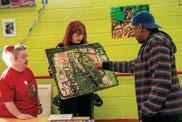
There’s hope within the field that Look Here will raise awareness at a crucial inflection point. “It’s super important for us at CCW, but it’s really important for the field that Pew is willing to fund this project and put a spotlight on this work,” says Bartol. “I don’t think there’s ever been an exhibition that brings together the amount of work from this number of studios at one time.”
The Haverford-CCW partnership has has long been nurtured by Lindgren, who teaches a first-year writing seminar called “Portraits of Disability and Difference.”
The course, which examines how disability is portrayed, treated, and discussed in visual art, literary art, and in the media, was transformative, says Lindsey Lopes ’16, who recently completed her Ph.D. in biosciences at Rockefeller University. “It provided language and perspectives I had not previously been exposed to but that resonated deeply with my lived experiences.” Her brother is Christopher Lopes,


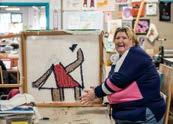
a professional actor with Down syndrome. “The introduction that I got to disability studies during that seminar allowed me to approach other courses I took at Haverford with a different perspective.”
A few years after taking the seminar, several students including Lopes and her roommate, Sarah (Waldis) Revak ’16, approached Lindgren about doing an independent study in disability studies. “Kristin is an amazing professor and person, and I wanted the opportunity to learn from her again before I graduated,” says Revak, a Philadelphia pediatrician. “Especially as a pre-med student, I felt there was a lot I could learn from disability studies about the social model of disability, which examines disability as an interaction between individual impairments and societal barriers and discrimination.”
Lopes, Revak, and Lindgren eventually designed “Critical Disability Studies: Theory and Practice,” a course where Haverford and Bryn Mawr students examine recent work in critical disability studies across a range of disciplines, including literary studies, visual studies, and history. They explore
ARTISTS IN ACTION:
(clockwise from left) Allen Yu at the drafting table; Paige Donovan in the studio; Jenna Powers with a work in progress; Clyde Henry with one of his signature animal sculptures; Brandon Spicer-Crawley, Donovan, and curator Jennifer Gilbert discus one of Spicer-Crawley’s paintings; and fabric artist Cindy Gosselin with one of her large creations.

the historical and theoretical development of the ideas of normalcy and disability; questions around ethical engagement and inclusive design; and disability arts, culture, accessibility, and exhibition practices.
The course includes a semester-long partnership with CCW, where students and artists have collaborated in numerous ways—from making artwork together to interviewing each other for audio pieces to co-teaching grade schoolers woodworking techniques—always with a culminating co-curated exhibition.
“As part of the course design we proposed a community partnership, although we didn’t yet know which organization we were going to partner with,” Lindgren says. “We were looking for a place that was financially and physically accessible to artists with disabilities, a place whose philosophy and values aligned with disability justice principles, a place that supports people as agents in their own lives.”
In 2015, Lindgren, along with Lopes and Revak, visited CCW—which was in 1972 known as the Lower Merion Vocational Training Center and transitioned to CCW
in 2010. “I just fell in love with the place,” she recalls. It was the beginning of a collaboration between Lindgren, Bartol, and CCW exhibitions manager Samantha Mitchell. “When we first met with CCW,” Lindgren says, “they told us that they wanted the opportunity to exhibit their work, and they wanted documentation of the project.”
Each year, students and artists collaborate to curate a small exhibition in the Visual Culture, Arts, and Media building (VCAM) or the Haverford library. In preparation, students talk with artists about their work, write the wall text and catalog copy, record audio descriptions of each work displayed, and think broadly about exhibition accessibility. They plan an opening event that welcomes artists and their families and gives the broader Haverford community an opportunity to meet the artists and learn about their approaches to artmaking.
The partnership project is different every year. Students and artists have created work both individually and collaboratively—bioart in Haverford’s biology labs; action figures in VCAM’s Maker Arts Space; embroidery, collage, and printmaking in CCW’s studio—and through working together
SEPT. 19–DEC. 13, 2025
The Look Here project includes a group exhibition at Haverford’s Cantor Fitzgerald Gallery featuring the work of six artists from the Center for Creative Works (CCW), co-curated by Jennifer Gilbert, Mary T. Bevlock, and Paige Donovan. The artists featured will be Kelly Brown, Cindy Gosselin, Clyde Henry, Tim Quinn, Brandon Spicer-Crawley, and Allen Yu. An opening talk and reception will be held Sept. 19 from 4:30 to 7:30 p.m.
SEPT. 19–DEC. 13, 2025
Look Everywhere , a group exhibition of CCW artist works, will be featured at the Visual Culture, Arts, and Media building (VCAM).
OCT. 1–OCT. 31, 2025
Look There , an exhibition featuring the work of artists from progressive studios across the country, will be on display at Atelier Gallery in Philadelphia, with an opening reception on Oct. 1 from 5 to 7 p.m.
OCT. 20–OCT. 23, 2025

The sixth annual Creating Community Symposium will be held in Philadelphia in collaboration with the Creative Growth Art Center.
NOV. 5, 2026
Look Here will release a first-of-its kind publication on the work of progressive studios. Tim Quinn, “Untitled (Kitchen)”
they build relationships, a primary goal of the partnership. Artists enjoy interacting with students, having access to spaces like VCAM and Haverford’s arboretum, and exhibiting their work. For instance, Paige Donovan—an artist who began at CCW after she graduated from Saint Katherine School’s high school program at Archbishop John Carroll High in 2012, participated in the project that taught woodworking to an afterschool program. “I got to teach kids to do woodworking, mostly building cars and spinners,” she says, noting that she really appreciated the experience of teaching kids. Students enjoy forming relationships with artists, learning about their art practices and daily lives, and developing skills in accessible exhibition planning.
Engagement with the surrounding community is central to Haverford’s ethos and to CCW’s mission, says Lindgren. Guided by the principle of reciprocity, “the partnership brings our communities together and benefits both CCW artists and Haverford students.”
For the first year’s bioart project, which used bacteria grown in Petri dishes to create art, CCW artists came to Haverford’s biology labs, where students including Lopes and Revak showed them how to use microscopes, along with other basic lab protocols. Students went to CCW and practiced embroidery and other fiber arts projects. For the past few years, CCW artists learned to use equipment such as 3D and laser printers at Maker Arts Space under the guidance of Kent Watson, and this year, created 3D action figures of themselves.
“As a science person, I didn’t always consider myself a creative or artistic person, so the opportunity to create art and learn from CCW artists wasn’t something I expected for my senior year of college,” says Revak. “I learned from the CCW artists the many parallels between science and art, and I now think of science and experimentation as a much more creative process than I previously did.”
“Our artists really feel connected with the school at this point,” says Mitchell. “They expect to see the students in the spring to work with them on different projects. And when they go to campus, they feel a great sense of ownership around the different spaces there.”
Look Here—the brainchild of Lindgren, Mitchell, and Matthew Seamus Callinan, associate director of Cantor Fitzgerald Gallery, VCAM, and Campus Exhibitions—will focus a national spotlight on disability arts and strengthen and expand the Haverford-CCW partnership.
Look Here’s primary exhibit is a group show featuring six CCW artists at the Cantor Fitzgerald Gallery, co-curated by U.K.-based Jennifer Gilbert, who works with and champions disabled and neurodivergent artists, and two CCW
artists: Donovan and Mary T. Bevlock. “The idea is that these six artists have been selected and we’re going to have at least three works from each in that show, so people get a fuller picture of those artists and their capabilities,” says Callinan, who is project producer of Look Here
A satellite show at VCAM will feature one piece of work each by other CCW artists. A third exhibition, also curated by Gilbert, will be held at Philadelphia’s Atelier Gallery and will showcase artists from some 30 progressive studios nationwide. Donovan will represent CCW at that show with some of her detailed embroidery work. It’s an exhibition that is unprecedented in scope, says Callinan.

“To bring them together and showcase their talents is a dream,” Gilbert says. “A few artists have received contemporary art world success, but I think it’s important to keep drilling home the message to curators to look more broadly, and head into progressive art studios to see the abundance of talent. These artists should be included in group and solo shows in museums and contemporary art spaces.”
Callinan and Lindgren have worked closely to ensure that Look Here’s exhibitions and talks will be accessible to people with varying disabilities and needs—similar to a 2012 disability arts exhibition at Cantor Fitzgerald that the two worked on, called What Can A Body Do?
That exhibit featured art by artists with disabilities (though not necessarily neurodivergent artists). It was the first that the two specifically tailored to be accessible, and it was named one of the 50 most important shows for artists with disabilities in the last 50 years by Art in America.
“We want to model what an accessible art exhibition can look like,” Lindgren says. “Accessibility is never perfect, but we want everyone to feel welcomed into these gallery spaces, and we want arts professionals to see how they might provide access at exhibitions they are developing.”
There will be braille materials, audio descriptions, and American Sign Language embedded in video, along with captions for viewers who are deaf and hard of hearing. “Matthew [Callinan] also thinks about physical accessibility of space, with wide pathways for wheelchair users and different heights rather than set heights at which we hang things,” Lindgren says.
The Creating Community Symposium, an annual national gathering of progressive studios, will be held during Look Here, the first time it’s to take place on the East Coast. “It gives us a chance to show off our studio and our artists,” says CCW’s Bartol, who’s coordinating the symposium. “And it gives access to studios on the East Coast that haven’t been able to attend the West Coast

CREATIVE CHAMPIONS: (clockwise from left) Kristin Lindgren and Matthew Seamus Callinan have been instrumental in the College’s collaboration with the Center for Creative Works and the Look Here exhibition; “No No” by Brandon Spicer-Crawley; “Cow” by Clyde Henry.

symposiums, because we all have small budgets. There are a lot of smaller studios that we’re hoping will be able to come, to find collegial kinship and learn and grow.”
Bartol expects 150 progressive artists and staff to gather for presentations, discuss current projects, share best practices, and hear panel talks and a keynote speech on the future of art made in progressive studios and its increasingly significant place in the contemporary art world.
Recent major successes by artists include the first solo exhibition by an artist with a developmental disability at New York’s Museum of Modern Art, California-based Marlon Mullen, in December 2024. And in October 2023, San Francisco’s Museum of Modern Art announced a partnership with Oakland’s Creative Growth Art Center, purchasing more than 100 works by artists from Creative Growth’s three affiliated Bay Area studios.
“These artists are starting to be taken more seriously, getting shows at larger institutions, and representation at major galleries,” Callinan says, “not necessarily because of their disability, but because of their artwork. I feel like, honestly, that [Look Here is] maybe a next big step in that.”
“These aren’t isolated, outsider figures that have sometimes been fetishized in the art world,” says Lindgren. “We’re hoping that Look Here will highlight a different way of understanding the work that these artists are doing.”
Additional reporting by Brian Howard.
Seven Fords were recognized for their service to the College, society, and their professions at Alumni Weekend.

The KANNERSTEIN AWARD for loyal and active service to the College was presented to John Morse ’73 who has been a member of the Haverford Corporation since 1974 and a member of the Board of Managers for 12 years. He has served as a member and clerk of the Corporation Standing Nominating Committee and is now completing his second 12-year term on the Corporation Advisory Committee. As clerk of the Advisory Committee for six years, he was instrumental in implementing historic revisions to the Haverford College bylaws that now allow Corporation membership to people who are grounded in the faith and practice of Friends, regardless of their membership in the Religious Society of Friends.

Woody Neighbors ’75 received the HAVERFORD AWARD for his work as a public health social psychologist who writes about the intersection of structural determinism and individual coping capacity in the production of racial disparities in disease. His most recent study demonstrated how adult Black men with diabetes and hypertension can come together in small groups to help each other manage chronic disease through lifestyle change and engaging doctors in open and honest conversation.

The DISTINGUISHED ACHIEVEMENT AWARD recognizes an alum’s accomplishments in their field and was awarded to Daniel Dae Kim ’90. The actor, director, producer, and social advocate is widely known for his work in ABC’s Lost, CBS’s Hawaii Five-O, Netflix’s Avatar: The Last Airbender, and
Disney’s Raya and the Last Dragon. Most recently, Kim was on Broadway starring in the Roundabout Theatre Company’s production of David Henry Hwang’s Yellow Face, which received rave reviews.

The FORMAN AWARD
honors Larry Forman ’60 by recognizing alumni athletes who have devoted themselves to the betterment of society. Anjan Chatterjee ’80 received the award this year. He is a professor of neurology, psychology, and architecture and the founding director of the Penn Center for Neuroaesthetics at the University of Pennsylvania. He wrote The Aesthetic Brain: How We Evolved to Desire Beauty and Enjoy Art and co-edited Brain, Beauty, and Art: Essays Bringing Neuroaesthetics into Focus, and The Roots of Cognitive Neuroscience: Behavioral Neurology and Neuropsychology. At Haverford, he was track and field coaching legend Tom Donnelley’s first All-American athlete and co-captained the indoor and outdoor track teams. His school long jump record still stands.

The WILLIAM E. SHEPPARD AWARD, which recognizes exemplary service for alumni activities, was presented to Mitchell Cohn ’80. Mitchell previously served on the College’s Alumni Association Executive Committee. Today, he interviews prospective students, represents the College at local fairs, and organizes alumni activities. Mitchell is on the Rainbow Quorum affinity group steering committee, remains active on Haverford Connect, and contributes to the College’s art and historical collections. He also assists the Clark Hulings Foundation, honoring the namesake American artist and alum Clark Hulings ’45, whose biography was recently published.
The YOUNG ALUMNI AWARD recognizes established and future leaders among Haverford’s alumni who have graduated within the past decade. Once again this year, it was presented to two recipients.

Carlotta Pazzi ’20 is a resident physician in internal medicine at the Johns Hopkins Hospital. While attending medical school at the Sidney Kimmel Medical College through the Haverford-Jefferson Scholars Program, she served as co-president for Refugee Health Partners, an organization aimed at providing better access to care for immigrant populations in Philadelphia. She also created and implemented a health literacyfocused ESL class for refugee populations in the city. Carlotta—the first person in her family to pursue an international education and a first-generation physician—remains committed to mentoring Haverford’s international students pursuing medical school.

The first person in her family to graduate from college, Leslie Patricia Luqueño ’20 became a Ph.D. candidate at Stanford University’s Graduate School of Education and has focused her research on the intersection of race, higher education, and immigration. At Haverford, she was co-president of the Alliance of Latin American Students, a Customs team member, a Students’ Council representative, and a Mellon Mays Undergraduate Fellow. Leslie also worked at the Office of Admission as a head intern of the Institutional Diversity, Equity, and Access team. Since graduation, Leslie has been one of the most engaged alums to work in the College’s Office of Admission. She has been a dedicated alumni interviewer and application reader, having conducted 34 student interviews and read nearly 400 applications.
At its meeting in April, Haverford’s Board of Managers welcomed three new members.

Laura K. Howard ’90 recently joined Golden Seed, an early-stage investment firm focused on women-owned and -led companies. She worked previously for Morgan Stanley’s healthcare group for 27 years. Between 2013 and 2024, she was based in Hong Kong as a senior advisor for Morgan Stanley’s Asia-Pacific franchise, focused primarily on helping finance and expand hospital and primary/secondary care providers across South and Southeast Asia. At Haverford, Howard earned honors in economics and was a member of the field hockey and lacrosse teams. She served on Haverford’s International Council from (2011–2013). Laura and her husband, Dieter Turowski, recently relocated to Palo Alto with their twin boys, Max and Sebastian, who are currently high school freshmen.

Alan Klein ’81 is a Partner with Simpson Thacher & Bartlett LLP, where he practices in the corporate department. Alan joined the firm in 1984 and became a partner in 1993. He served as co-head of the firm’s mergers and acquisitions practice (2016–2021) and is a former member of its executive committee. He has represented Microsoft in numerous acquisitions, Twitter’s board during the sale to Elon Musk, and Aetna’s board when CVS Health acquired the insurance company for $78 billion. He is the 2024–2025 Douglas and Samara Braunstein Visiting Professor of Law at Harvard Law School and a rare book collector focusing on first editions of poets like Seamus Heaney, Wallace Stevens, William Carlos Williams, and W. H. Auden.
Carolyn Risoli P’24 was the founding president of Marc by Marc Jacobs, where she launched ready-to-wear clothing and accessories and built a multi-category, global footprint. She is executive chair at Boston-based women’s clothing brand Nic+Zoe and also co-founded Mission Statement Apparel, LLC with actor Hilary Swank. Carolyn received her BA from The College of the Holy Cross in Worcester, Mass., where she is a member of the Board of Trustees. Carolyn also served on the Board of Trustees for International Preschools (2011–2022). In addition to her role on the Board of Managers, she is a member of Haverford’s C6 Campaign Executive Committee. Previously, Risoli and her husband, Joe Silvestri, were members of the College’s Parent Leadership Council. They have two children, Alex Silvestri ‘24 and Olivia Silvestri, a member of the University of Pennsylvania’s class of 2026.


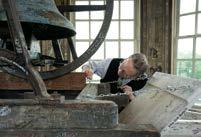


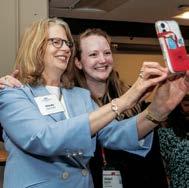
. 5. Making music during a jam session on Founders Porch
6. A quick selfie with Haverford President Wendy Raymond
7. Exploring the universe at the Strawbridge Observatory Open House
8. Catching up with old friends at the welcome dinner
9. Celebrating longtime coach Fran Rizzo on the Haverford cross country course See



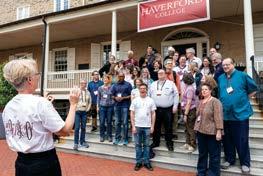
Posing with the Class of 1990 11. Learning about the Haverford Innovations Program with Director of Haverford Entrepreneurship Program Shayna Nickel
12. Sharing poetry at the open mic





By Ron Jenkins ’76
“The straight path was lost.”
Dante’s “Divine Comedy” – “Inferno” – Canto I, line 3
I have learned a lot about losing the straight path in life from the men and women I’ve met in prison, beginning in 1990 when I was arrested in South Africa during anti-apartheid demonstrations.
The dozens of men packed into our tiny cell refused to submit to their captors. For hours, they sang protest songs that would soon become the soundtrack to the downfall of the apartheid government. The men were using music as an instrument of resistance, defying the injustice of their imprisonment by stubbornly singing their freedom into existence. When the guards noticed I was the only white person in the group and offered me the opportunity to leave, I chose to stay and learn more about the
transformative power of art behind bars. I might never have had the opportunity to spend time in that prison, or the others I have been in since, had I not learned the value of losing the “straight path” at Haverford. When I applied to Haverford, I was living in a small storage trailer hitched to a rickety Rambler sedan. I had dropped out of New York University and was performing as a clown and juggler in a one-ring tent circus. I loved traveling with the circus, but I was uncertain about my future when I read about Haverford President Jack Coleman taking sabbaticals to work as a garbage collector and dishwasher. I thought a college that would hire a president like that might be a good place for a student like me, and I was right.
At Haverford it was okay to stray from the “straight path.” My professors encouraged me to pursue unconventional routes of study. In physics class, Bruce Partridge let me demonstrate the principles of angular momentum by juggling tennis rackets. Joe Russo and Paul Desjardins, who had introduced me to the modern relevance of ancient Greek and Latin texts, recommended me for a Watson Fellowship to spend a year

in Bali studying sacred temple clowns, whose performances reimagined the “Ramayana” and “Mahabharata” as commentaries on current events.
The Balinese clowns invited me to perform with them and I eventually wrote a trilogy of books about their theatrical traditions, but not before taking a detour to graduate school at Harvard where my professors were as open to unconventional pathways as my professors at Haverford. I wrote my doctoral dissertation on “Comedy and Democracy in America” under the mentorship of Robert Brustein, who recommended me for a Sheldon Fellowship that sent me to Italy where I spent a year traveling with the theater company of actor and playwright Dario Fo, who later became the first clown to win a Nobel Prize in literature.
When Fo was invited to tour America, he considered my experience with the rhythms of circus clowning as qualification to hire me as his onstage simultaneous interpreter. The show performed to standing ovations at the Joyce Theater in New York, the Kennedy Center in Washington, D.C., and the Yale Repertory Theater in New Haven, Conn., where I have been teaching since 2015 as a visiting professor at Yale’s Divinity School. Sometimes, we hold the course in prison where my students experience the power of the arts behind bars by collaborating with incarcerated men and women in performances inspired by Dante’s “Divine Comedy.” Our partners note that Dante’s medieval journey out of hell has a lot in common with their journeys out of prison.
Dante wrote in exile, after having been convicted of crimes and sentenced to death if he ever returned home to Florence. So, it is not surprising that the pilgrim in his poem loses the “straight path” and makes his way through hell and purgatory in a series of spirals. Spiral paths make journeys longer, but richer, providing opportunities to see things that would be missed on a more direct route. Spirals echo the structure of DNA, the key to life’s pathway of evolution.
I am grateful that Haverford validated my instincts to travel in spirals, which I
continued on page 72

As part of the Care Fair’s wellness offerings, students connect with therapy goats for a moment of calm and comfort amid the end-ofacademic-year bustle.

Due to privacy concerns, the Class News section is not included in the digital edition of Haverford Magazine.

Due to privacy concerns, the Class News section is not included in the digital edition of Haverford Magazine.
56 Bob Greer, III, M.D., 90, of New Oxford, Pa., died on March 27 at his home at Cross Keys Village - The Brethren Home Community after a long illness. After Haverford, he received a medical degree cum laude from Harvard Medical School and completed his surgical internship and a year of residency at the University of Michigan before being drafted into the U.S. Army. He served at the Walter Reed Army Institute of Research before beginning his residency in orthopedic surgery at the University of Pittsburgh. He joined the faculty there before moving on to become the founding chief of orthopedic surgery at the Penn State College of Medicine, where he remained until retirement. He was a leader in professional societies, a prolific journal author, and a lifelong mentor to his residents. Greer loved volunteering, sailing, spending time with his pets, reading, and birdwatching. He was warmhearted, kind, and generous. He was a man of few words, but when he had something to say, it was worth hearing. He is survived by his beloved wife and caregiver, Barbara McCarthy. He is also survived by daughters Patricia Blouch and Susan, and two grandchildren. He was predeceased by his first wife, Martha.
57 Ben Hart, 88, of Pittsboro, N.C., and Hudson, Ohio, died on Oct. 16, 2024. He earned a Ph.D. in economics from Ohio State University and worked for many years on Capitol Hill, including as staff director and chief economist for Rep. Chalmers Wylie, ranking member of the House Banking Committee, before retiring to North Carolina to be close to family. Hart was a person of faith, mostly because of his experiences at Haverford. The Civil Rights Movement propelled him to be involved in politics. Not long before he died, he remarked that he was happy to have lived long enough to see a Black president twice elected to office,
and he had hoped to vote for Kamala Harris and to see a Black woman as president. Hart supported education in every way that he could, believing that he had a responsibility to young people’s aspirations for accomplishment. He saved numerous family documents and genealogical records for his present and future kinfolks. He loved his family. He was proud to have a personalized license plate that read, “Uncle Ben.” He was a member of Binkley Baptist Church in Chapel Hill. Hart is survived by his brother, five nieces, a nephew, and nine great-nieces and nephews.
58 Jim Bucy died peacefully on Feb. 23 in Chesterfield, Mo., at the age of 88. A devoted husband, father, grandfather, and great-grandfather, Bucy was known for his quiet wisdom and unwavering love for his family. He found great joy in the simple pleasures of life. An avid reader, he was rarely seen without a book in hand, constantly seeking knowledge and enjoyment through the written word. His love for the open water drew him to sailing, where he cherished the tranquility and freedom that came with it. His professional accomplishments included becoming a major in the U.S. Air Force as part of a six-physician medical corps for the Apollo 11 moon landing. He was an assistant professor of urologic surgery at Washington University and in private practice. He was preceded in death by his brother, Craig Bucy ’57. He is survived by his loving wife, Jane, and by his children, Robert, Jean Graff, Joan Groos, Michelle, and Christine Reisman, as well as five grandchildren and two great-grandchildren. Additionally, he is remembered by his former wife, Judith.
62
Gary Blauvelt of Baltimore, Md., died (or, as Gary might have preferred, per a family obituary, “shuffled off this mortal coil” or “kicked the bucket”) peacefully on April 9, after a brief illness. He earned an MAT from Harvard University in 1963 and taught English at Friends School Baltimore from 1963 until his retirement in 2004. After moving to Roland Park Place, a retirement community in Baltimore, in 2007, he taught a weekly
poetry class—more than 750 sessions. He made many friends at Friends School, at Roland Park Place, and on his twicedaily walks through Hopkins/Homewood and Roland Park neighborhoods. Gary will be remembered for his love of music, movies, and poetry, and for his sense of humor.
Bob Jenks died peacefully on March 31, 2024, just shy of his 84th birthday. A proud Sidwell Friends alumnus and natural athlete, he played football at Haverford before joining the U.S. Navy. His 28-year naval career took him from the Mediterranean to Trinidad and Tobago, culminating in retirement as a commander. Jenks later continued his service as a civilian with the General Services Administration and the Navy. He shared a life of travel and adventure with his beloved wife, Karen Mahan Mackey, exploring Europe, Africa, and South America. An avid outdoorsman and big game hunter, he was active in the National Wild Turkey Federation and several African safari clubs. He will be remembered for his courage, curiosity, deep love of nature, and a life well lived in service and exploration.
63Put Barber died at his home in Seattle on March 8. He attended graduate school in sociology at the University of Pennsylvania and had two children with his first wife, Patricia Holland. Barber then joined an experimental new federal volunteer agency, ACTION, in Renton, Wash., where he met Valerie Lynch, whom he married in 1973. He worked for Washington’s Office of Voluntary Action; the state’s Office of Community Action; the Seattle office of the Federal Community Services Administration; and the 1989 Centennial Commission. Barber also taught about nonprofits at Seattle University and the University of Washington. He was an active volunteer and president of the Residents’ Association at Skyline, his and Valerie’s senior community. Barber is survived by his wife, Valerie; his son, Jonathan “Jasper” Lieber; his daughter, Lucy; and by a grandson, siblings, and other family and friends.
Will Phillips died suddenly in April. An inspirational classmate, Phillips was known for his adventurous spirit and boundless curiosity. After a successful career as an educator and counselor, he founded REX Roundtables, a leadership forum for industry executives to share strategic insights within exclusive peer groups, fostering deep connections at the intersection of professional growth and personal experience. His life was marked by service, exploration, and a talent for building lasting community. His charisma and zest for life left a lasting impression on all who knew him. He will continue to live on in the thoughts of his loving wife, Mary; daughters Laura, Katharine, Marion, and Anna; six grandchildren; a great-grandson; and a professional community who were touched by his life and light.
69Spencer Hipp, age 77, died Nov. 18, at Hinds Hospice in Fresno, Calif., after suffering successive strokes in September and November. After Haverford, he served a 30-year career as a U.S. Naval Officer, retiring as captain. In his civilian life, he attended McGeorge School of Law, graduating in 1979, and practiced for 36 years as a shareholder in the Fresno office of Littler Mendelson, the largest employment and labor law practice in the world, representing management. He was a strong, quiet, methodical man with a dry sense of humor. When he retired from the Navy, his excess energy went to day hiking. He loved the solitude and majesty of Yosemite and Sequoia & Kings Canyon, covering up to 28 miles in a day and climbing Half Dome nine times. Without question, his greatest love was for his family. Each note tucked inside a lunchbox, toot of his horn echoing over a water polo game, hot-dog pizza, lightstick for a grandchild, or emergency sandwich and cookie supply for the trip home said “I love you” without words. But, he also made sure to give us the words: “Have a great day and know that I love you!” Hipp is survived by his wife, Susan; their three children, Matthew, Daniel, and Jaime; and seven grandchildren.
Marshall Schwenk died on Feb. 1. After Haverford, he taught at a private school, worked as a line cook in California, taught
at-risk youth in Maryland, and started his own property cleanup business. He married his first wife, Margiana Stotelmeyer, and divorced in 1975 before moving back to Pennsylvania and meeting his second wife, Barbara. Schwenk’s favorite thing to do was work with his hands. Construction was his bread and butter, but what he loved most was carving beautiful sculptures from rare woods he had accumulated over the years. When he and Barbara moved to the Eastern Shore of Virginia in 1996, he began renovating an old three-room cabin as his and Barbara’s home on Church Neck. He also built a horse barn, a chicken coop, a huge shop, and several other buildings. His greatest joy and accomplishment was raising his granddaughter, Nichole, from the time she was two years old. He loved her company and taught her how to shoot an arrow, drive a stick shift, and build a fire in the woodstove. He was a loving husband, a devoted grandpop, and kind to people and animals. Schwenk is survived by his wife, Barbara, to whom he was married for 45 years, as well as by his son Nathan Toms, his granddaughter, and three dear nieces and nephews.
70Felmon Davis died at the age of 76 on May 7 in his adopted home of Mannheim, Germany. Before his retirement in 2018, he was a professor of philosophy at Union College in Schenectady, N.Y. He earned his Ph.D. in philosophy at Princeton, and his research centered on moral theory and the philosophy of religion. His style in philosophical debate was not adversarial, but invitational; he thought it his duty to present his position as attractively as possible in order to invite colleagues to join him. He was an early adapter to all things digital and to computer ethics and metaphysics in particular. In retirement, Davis was a regular visitor and guest at the doctoral colloquium in political theory at Gießen University. His reputation was legendary among the students he met and taught at Frankfurt, Darmstadt, Gießen, and Hamburg. He taught his final course on “Fear, Truth, and Democracy” in the Winter of 2021–2022 at Hamburg University. Davis is survived by his wife, Elisabeth Egetemeyr.
continued from page 52
continue to do whenever possible, directing plays in prisons in Indonesia, Italy, and the U.S. The Robert F. Kennedy Human Rights organization invited me to stage a play in an Italian prison as part of this year’s commemoration of the hundredth anniversary of Kennedy’s birth. Kennedy’s famous speech about the importance of “a ripple of hope” recalls the words engraved over hell’s gates in Dante’s “Inferno”: “abandon all hope.” Incarcerated readers do not see that message as an obstacle. For them, it’s a challenge to embark on alternative paths.
“‘Abandon hope,’ I can’t accept that,” said Larry White, who spent decades in prison and believed that “what Dante was really saying was, if you go into a place that has a sign like that on the door, you have to bring the hope in with you.”
Dante’s journey from the gates of hell to the heights of heaven takes over 14,000 lines of sublime poetry ingeniously structured in a terza rima pattern of spiraling rhymes.
Fifty years after graduating from Haverford, my spiral path has led me to teaching Dante’s poem at Yale, in prison, and at Wesleyan University, a small liberal arts college like Haverford, where I have been a professor of theater for half of those 50 years, and where I hope that seeing Dante’s poem through the wise eyes of individuals who have survived the hell of incarceration will inspire students to consider the advantages of leaving the “straight path” for unconventional routes to fulfillment, as predicted for Dante by his teacher Brunetto Latini:
“If you follow your star, you’ll surely find your way to a glorious destination.”
Dante’s “Inferno” – Canto XV, lines 55–56
Ron Jenkins is a recipient of Guggenheim and Fulbright Fellowships whose prison theater work has been supported by the Asian Cultural Council, Robert F. Kennedy Human Rights, and a residency at the Rockefeller Foundation’s Bellagio Center.
By 2019, the Haverfarm had blossomed in its role as a vital agricultural space on the southeast corner of campus. Maintained by students, staff, and volunteers from the surrounding community, the farm had become an essential hub for sustainability education and community engagement, offering public workshops and a regular pop-up farm stand.
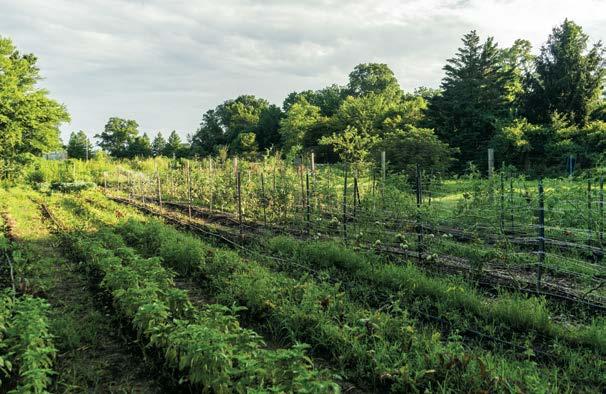

Six years later, the farm is greener and more productive than ever. With expanded infrastructure—including a classroom, apiary, hoop house, deer fence, and redesigned community plots—the farm has evolved both its growing practices and its mission. What hasn’t changed is the Haverfarm’s commitment to growing community alongside fresh food.
